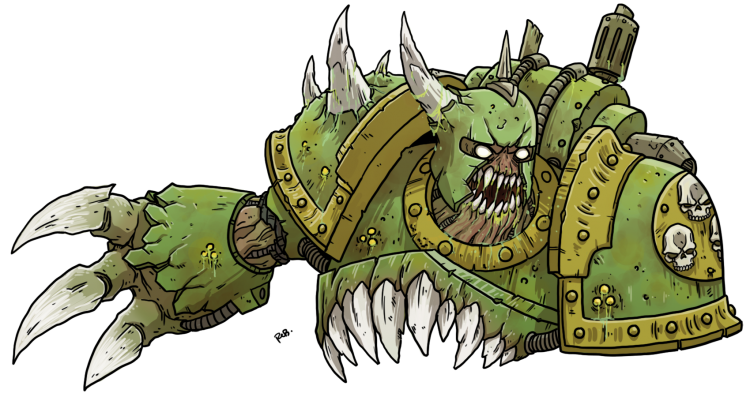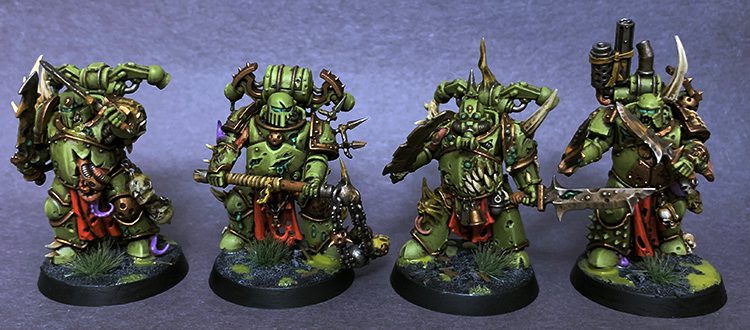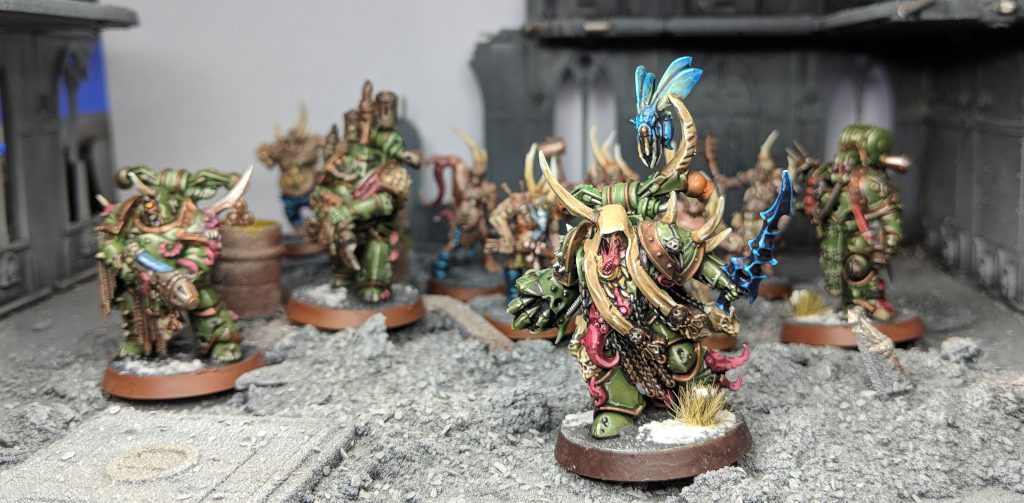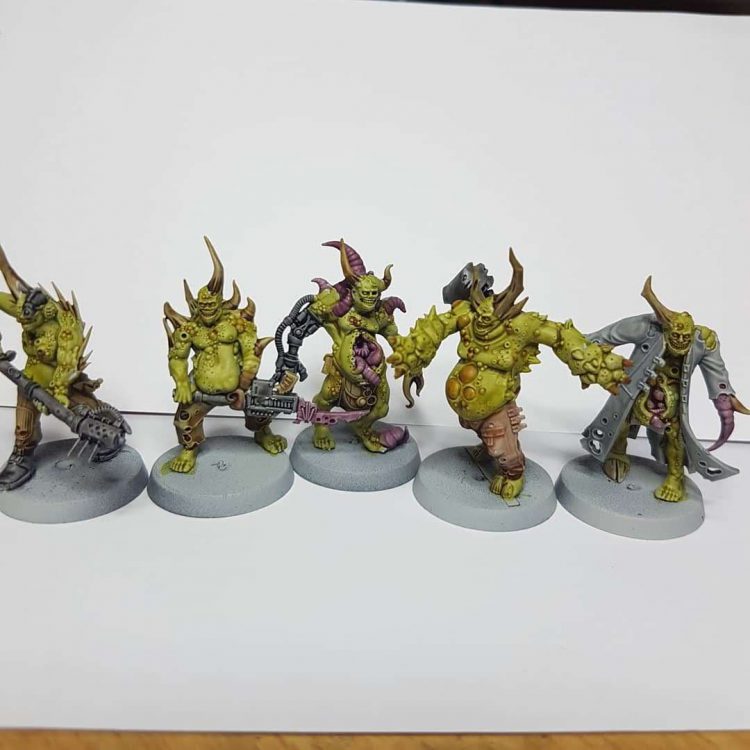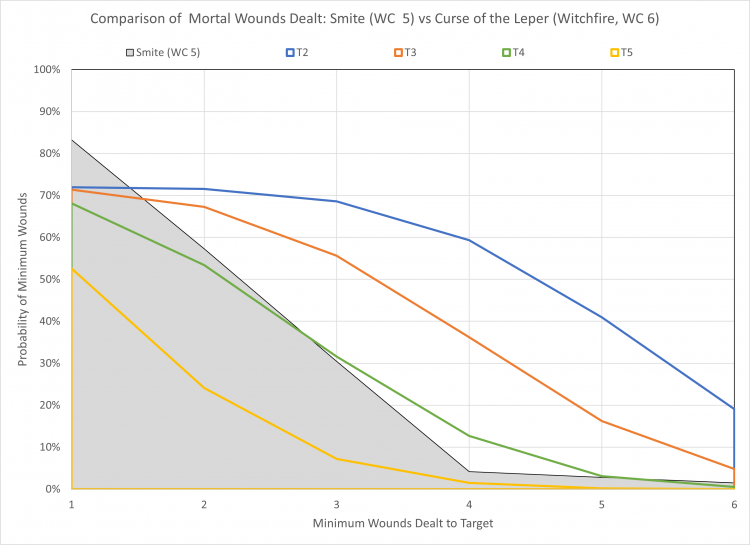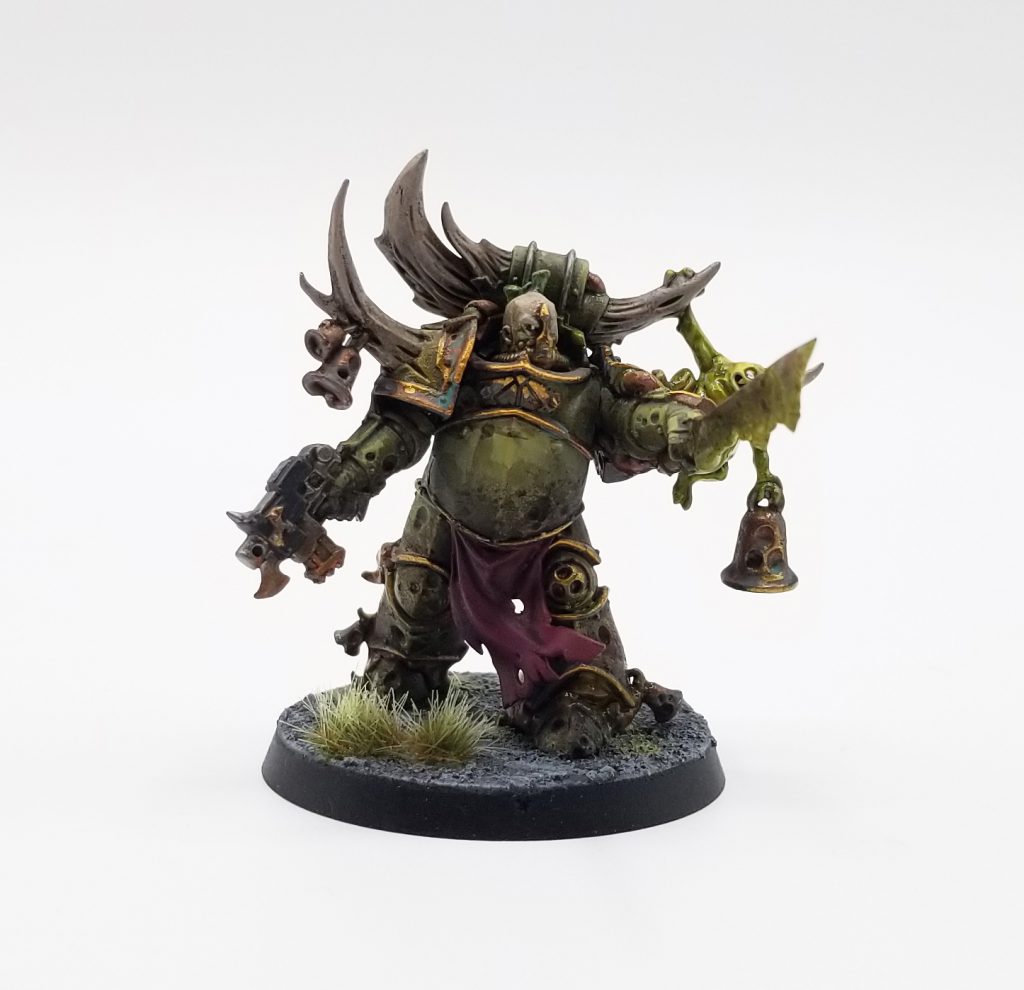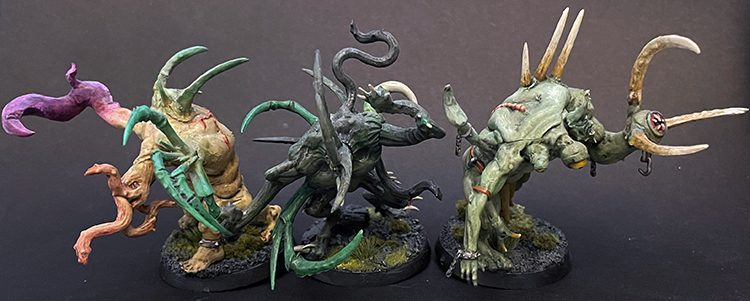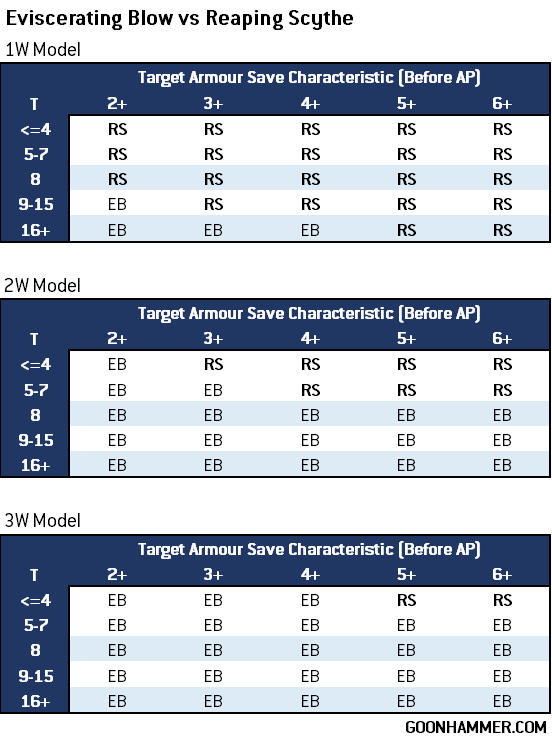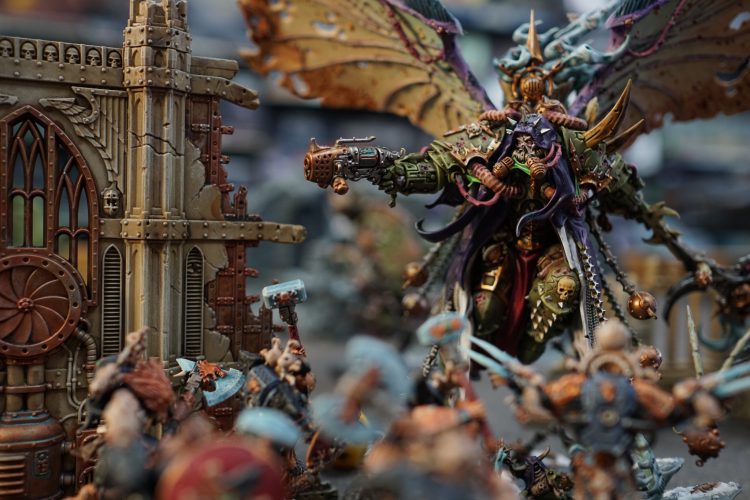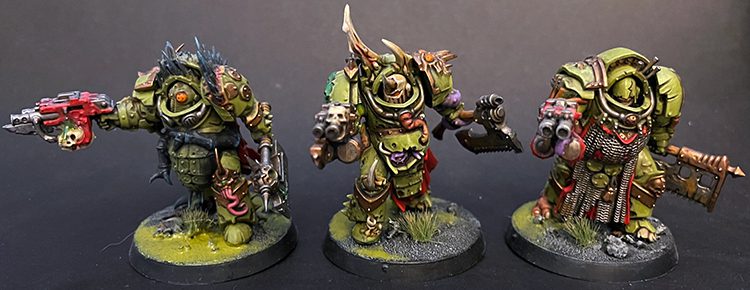STOP – This page is out of date. You can find our updated guide to playing Death Guard in 10th edition here: Start Competing: Death Guard.
Do you like being really, really hard to kill? Do you like to dish out your vengeance to enemies in a slow, methodical fashion? Do you think Nurglings are adorable? Then Death Guard may be the army for you!
Death Guard were one of the first codexes in 8th edition and spent most of the edition wallowing in that dreaded “early edition codex zone” where books are released and tend to be underpowered because the designers don’t yet have a feel for how the edition will play. They got a massive boost from War of the Spider at the tail end of the edition, and it was a boost strong enough to tide them over through the beginning of 9th. With their new Codex, Death Guard have been further enhanced, adding an additional wound to most of their infantry and gotten a host of weapon upgrades that make them a force to be reckoned with. They’re one of the toughest armies in the game, and while they pay for that by being painfully slow, they still very versatile, able to dish out wounds with psychic powers, shooting, and melee.
As with the rest of these articles, the idea is not to give an exhaustive review of every unit and option. Instead, we’ll cover each section with a general discussion of the good units, relics and stratagems, point out any traps, and then discuss how these pieces fit into a competitive army. We’ll also discuss where soup for Death Guard can have merit.
Also keep in mind that any competitive article represents a time and place. This was last updated on May 13, 2023.
Table of Contents
Strengths
- Resilience. Death Guard are pretty tough. Most of the army’s exclusive units benefit from extra toughness and the Disgustingly Resilient special rule, making them harder to take down and giving the army some real staying power. The army’s toughest units also sport invulnerable saves and they’re great at punishing armies which rely on 2-damage weapons.
- Contagions. The Death Guard army-wide bonus is access to the Contagion Nurgle’s Gift, which drops the Toughness of nearby enemy units by 1, with an increasing radius of effect every turn. This is a powerful ability that will often mean you’re wounding on a 3+ or better.
- Mortal Wounds. Between the Contagion Discipline and some of the Foetid Virion units, you have the ability to dish out a significant number of mortal wounds on a regular basis, helping you chew through tougher units like Custodes and Bladeguard Veterans.
- Plague Weapons. Most of the models in your army re-roll 1s to Wound natively with at least their melee attack and some will get that benefit with shooting attacks. This helps make up for the lack of AP on many of your weapons and combos well with the Contagion rules.
- Melee. Most of the units in your army are capable melee fighters, armed with plague weapons and sporting 2+ attacks. You also have a number of ways to buff them, making even 5-model squads of Plague Marines nasty melee opponents to deal with. Since Nephilim, the upgrades on plague marine units have become free, turning them into nasty little melee squads that can dish out surprising amounts of damage with cleavers and maces.
- Characters. The Death Guard have a number of very strong character options in the Elite slot that can buff the army and act as force multipliers. They’re all worth consideration in some build or another.
- CP Generation. While the Death Guard lean heavily on relics and Warlord traits in an environment that suppresses their use with lower CP totals, they still have the Tallyman, one of the game’s most reliable sources of CP, to help make up for the upfront costs.
Weaknesses
- Mobility. Death Guard are slooooowwwww. Your most resilient units will often pay for that with a lower Movement stat, making it difficult to run down enemy units with melee combatants. Getting across the table will mean taking a long walk most games unless you teleport or hop in a transport, so you’ll need to plan your movement carefully and look for opportunities to get free movement from charges.
- Mortal Wounds. As tough as the Death Guard are, they can’t take mortal wounds, which tear right through their defenses. Your options for screening units aren’t great either – Poxwalkers are terribly slow and you seldom want to wait behind them, leaving you to rely on vehicles and spawn. Death Guard armies are basically a free lunch for Thousand Sons, who can plow through deathshroud with mortals and easily pick up 30 VP on Wrath of Magnus and Psychic Interrogation every game.
- Predictable. Perhaps the biggest challenge to the Death Guard is that their game plan can often become predictable, making it difficult for them to adapt to opposing strategies and chance course if they’re going heavier on infantry.
- Long-Range Firepower. Death Guard have lots of great mid-range shooting and the ability to maintain double shots on rapid fire bolt weapons while on the move (so long as you don’t Advance), but lack a lot of heavy weapons and long-range firepower in their Codex. This is something you can partially make up for with Plagueburst Crawlers, though the change to indirect fire means you’ll want to find ways to get them line of sight where possible.
- Build Limitations. Death Guard have some severe build limitations when putting together an army – you can’t have more than one LORD OF THE DEATH GUARD in a Detachment, and you can only have one unit of Poxwalkers or Cultists for each BUBONIC ASTARTES CORE unit you take, which means every poxwalker squad requires a squad of plague marines, terminators, or possessed. These aren’t terrible limitations, but you will but up against them pretty often and they prevent you from going full in on horde strategies.
- Lord of the Death Guard. Piggybacking on that “build limitations” bullet point, something that has recently become more of an issue for Death Guard is that the army cannot have two non-psyker characters in the same Detachment, since all of the non-psyker options have the LORD OF THE DEATH GUARD restriction. This means building a Death Guard army without psykers is ironically more difficult than it should be. This is something that has become an issue as Grey Knights and Thousand Sons have made Abhor the Witch a much more useful secondary to take, even in its nerfed form.
Competitive Rating: Medium
The Death Guard didn’t get much help in Arks of Omen, and they certainly felt the loss of Armour of Contempt (though not as much as some factions). They still have some play in a meta which has largely gone back to focusing on 2-damage weapons, and the 4+ invulnerable saves on their terminators are more relevant than ever, but they still suffer from being extremely slow and often predictable, while an inability to handle mortal wounds keeps them from reaching the top tiers. That said, they’ve still shown success recently and are now back to posting the occasional TiWP.
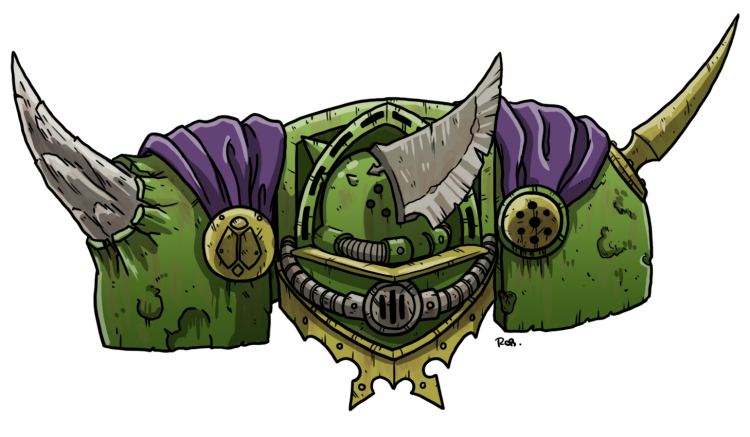
Death Guard Rules
Death Guard have a few special rules unique to their faction, and they’re now significantly divergent from the rest of the Chaos Space Marine factions.
Plague Weapons
Weapons with this ability re-roll To Wound rolls of 1. Note that it’s not just limited to melee weapons, and most of the units in the Death Guard army have access to at least one Plague Weapon. It’s a good bonus to have, given that Death Guard have neither Lieutenants nor Exalted Champions. It combines well with the Contagions of Nurgle rules to ensure that most of your melee attacks will wound on a 3+ and re-roll 1s – a decent consolation prize for having poor AP overall.
Don: Plague weapons are very strong. Innate rerolls of 1 to wound with your weapons that are usually wounding on 2+ or 3+ means that if you hit, you are very likely to wound which will force your opponent to roll saves. Even at a 2+ sv with AP- you will still get more wounds through than you would have without this rule.
The big thing to watch out for here is that there are several subfactions that can ignore re-rolls to wound altogether. When going up against the likes of Salamanders you’ll need to rethink your approach a bit and just make sure you overcommit to killing key targets.
Contagion Abilities
Contagions are a new rule introduced in Codex: Death Guard. These are abilities that affect enemy models or units within Contagion Range, a range that changes (increases) by battle round, starting at 1″ on battle round 1 and increasing to 3″, 6″, and 9″ on rounds 2, 3, and 4+, respectively. Contagions work pretty much like Auras – the effects of multiple Contagion abilities with the same name aren’t cumulative, so you can’t give someone -2 Toughness for being within Contagion Range of two units – but they are specifically not Auras and are not affected by abilities that affect Aura abilities, or vice-versa. Note that Contagion rules are separate from the rule for Nurgle’s Gift; it is possible for a unit to have – via a Plague Company, for example – a Contagion that is not awarded for the entire army being Death Guard. This ability still works as specified under the Contagion Abilities rules.
 Credit: Robert “TheChirurgeon” Jones
Credit: Robert “TheChirurgeon” Jones
Unit Rules
Disgustingly Resilient
Each time an attack is allocated to a model in this unit, subtract 1 from the Damage characteristic of that attack (to a minimum of 1). This replaces the older 5+ roll to ignore wounds from 8th edition and tends to be better on multi-wound models or about the same as the old ability until you start getting to weapons that do 5+ damage. This is something we’ve covered in detail in Hammer of Math. The short version is that this is one of the things that makes Death Guard so tough, especially now that there are a lot more D2 weapons out there. Note that there are still some ways to get ignore wounds rolls on top of this new Disgustingly Resilient, such as through the Plague Surgeon’s aura.
Remorseless
Units with this rule ignore any or all modifiers when taking Combat Attrition tests. This is something you see on Bubonic Astartes units and it’s helpful for ensuring that even when they do fail a morale test, it’s not too devastating. It’s worth noting however that you’ll rarely want to rely on this rule to avoid losing models.
Malicious Volleys
When a unit with this ability shoots Rapid Fire bolt weapons, model in the unit can make double the number of attacks if they’re within half range, is INFANTRY and remained stationary, or if the model is a TERMINATOR. When combined with Inexorable Advance this basically doubles the shooting output of Plague Marines and gives Blightlord Terminators some really nasty amounts of firepower to work with.
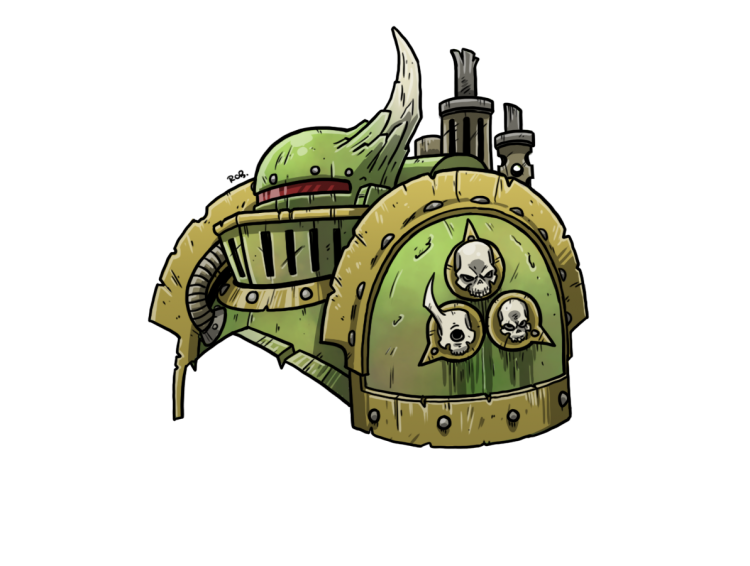
Detachment Rules
A Death Guard Detachment is one that only includes models with the DEATH GUARD or UNALIGNED keywords. If you’re running a Battle-forged army, then Death Guard Detachments get the Diseased Minions, Infernal Jealousy, and Foetid Viriion abilities, while BUBONIC ASTARTES models get Inexorable Advance and your Plague Marines and Poxwalkers get Objective Secured. Additionally, your Detachment can be from a specific subfaction called a Plague Company.
Inexorable Advance
If your army is Battle-forged, all BUBONIC ASTARTES models get the Inexorable Advance rule (note that the Daemon Engines in the Codex do not have the BUBONIC ASTARTES keyword, so this won’t apply to them, but it will apply to many of the Forge World units in Imperial Armour Compendium). This confers three benefits, each of which is a pretty nice bonus:
- The unit counts as having Remained Stationary if it did not Fall Back or Advance in its previous Movement phase. This means that Plague Marines can rattle off full BS heavy weapon shots on the move and can double-fire their bolters at full range as long as they aren’t Advancing or Falling back.
- If the unit is a VEHICLE, it doesn’t suffer a penalty for shooting Heavy weapons at targets in Engagement Range. This is mostly helpful for Helbrutes and Chaos Contemptors, since it doesn’t apply to any of the army’s Daemon Engines, i.e. the units that would really like to make use of it. It’s a fun treat that allows you to play more aggressively with some vehicles.
- If the unit has the INFANTRY keyword, it can ignore any or all modifiers to its Move characteristic, Advance rolls, or charge rolls. This is a very strong ability and thanks to some FAQs put out mid-year also applies to the penalty for moving across Difficult Terrain. This means that while most of your Bubonic Astartes Infantry have only a 5″ movement, they can move freely across and through most terrain, and make great use of Dense/Difficult for protection.
Diseased Minions
This is one of three army construction rules for the Death Guard. When you’re building a Death Guard Detachment you can’t have more units of Plague Followers (Poxwalkers or Cultists) than BUBONIC ASTARTES CORE INFANTRY, i.e. Plague Marines, Blightlords, Deathshrouds, and Possessed. This essentially prevents Death Guard from creating horde armies that consist of a ton of Poxwalkers and then characters to buff and support them, since you’ll always need some actual marine squads around. The good news is that your Bubonic Astartes options are pretty great and a lot of the army’s buffs and rules revolve around BUBONIC ASTARTES anyways, although you’re almost always going to want at least one unit of Poxwalkers.
Infernal Jealousy
Another army construction rule. A detachment can’t contain two LORD OF THE DEATH GUARD units and can only have a maximum of one DAEMON PRINCE. Note that the Daemon Prince has had his LORD OF THE DEATH GUARD keyword removed via errata in the Codex Death Guard FAQ, giving you a bit more flexibility, but it still means that if you want to double up on HQs in a Death Guard Detachment you’re going to need to take at least one Psyker, since combining a Chaos Lord, Lord of Virulence, or Lord of Contagion breaks this rule. The most common fix in a Battalion here is to run a Malignant Plaguecaster, which is fine since the Contagion Discipline is pretty good.
Where this is going to bite you is when you want to build an army that has no Psykers, usually so you can take advantage of the Abhor the Witch Secondary objective. In those cases you’ll likely need to run a Patrol or Vanguard detachment to ensure you don’t need more than one HQ choice.
Foetid Virion
The final army construction rule. You can include up to three FOETID VIRION units in a single Elites slot in your Death Guard Detachment as long as they all have different datasheets. This basically means that you can load up on the Elite Characters in the army like the Tallyman, Foul Blightspawn, and Plague Surgeon without worrying about losing space for your Terminators. It’s a helpful rule that makes taking Patrol detachments much easier for Death Guard.
Plague Companies
In a Battle-forged army <PLAGUE COMPANY> units in a Death Guard detachment can come from one of seven Plague Companies. Each Plague Company has a unique Stratagem, Warlord Trait/Contagion, and a Relic. These are essentially the subfactions of the Death Guard and they can add a lot of additional value to your army. They vary in competitive strength. You can’t put units from two different Plague Companies in the same Detachment, but your army can include two detachments from different Plague Companies, though many abilities like auras only affect units in the same Plague Company, meaning the value in doing this is limited. You can read more about them in the section on Plague Companies.
Army Rule: Contagions of Nurgle
The monofaction bonus for Death Guard: If every model in your army has the DEATH GUARD keyword or is UNALIGNED, then a unit with the Contagions of Nurgle ability gains Nurgle’s Gift (Contagion), which reduces the Toughness characterstic of models in enemy units within Contagion Range by 1. This is an incredibly powerful ability, and a lot to give up if you want to bring in say, Chaos Daemons. This is essentially the reason you won’t see many Death Guard Chaos soup armies outside of those that just use Mortarion or Plagueburst Crawlers, since dropping an enemy unit’s toughness by 1 is a huge boost for the army, particularly when it comes to melee, where the enemy will always be in rage. Note that, as we mentioned above, the benefit for being all Death Guard is getting Nurgle’s Gift, not Contagion Abilities generally – if your soup army includes a Warlord with a Plague Company Contagion, that will still work, but they won’t get Nurgle’s Gift.
The exceptions here are for Chaos Daemons and Chaos Knights. Chaos Daemons have a rule in their Codex which allows you to include a LEGIONES DAEMONICA detachment of Nurgle Daemons in a Death Guard army without losing the faction’s army-wide special rules, provided the total PL of the daemons detachment is not more than 25% of the army’s total PL. Likewise, Chaos Knights allow you to take a single super-heavy auxiliary detachment without losing Contagions, either, though note that you’ll pay 3 CP for that one.
Plague Companies
The Death Guard are organized into seven Plague Companies, each one of which acts as a subfaction for the army and gives you access to a unique Stratagem, a unique Warlord Trait Contagion, and a unique Relic. A Death Guard Detachment can belong to a single Plague Company, in which case every unit in the Detachment replaces its <PLAGUE COMPANY> keyword with the relevant Company. Most of the Death Guard auras and special rules for characters only affect units in the same Plague Company.
Taking a <PLAGUE COMPANY> detachment gives you access to the relevant stratagem and lets a character from that company take the relevant Warlord Trait, but you can only take the relic if you actual Warlord is either a member of the relevant Plague Company or Mortarion.
Harbingers
Typhus’ Plague Company is pretty lackluster and got way worse after the Death Guard lost their ability to play with Terminus Est in competitive lists.
- The Wrathful Dead (1 CP) – is used in the Fight phase, when a unit of HARBINGERS Poxwalkers are picked to fight. Until the end of the phase, they can re-roll hit rolls. This is pretty solid. It takes your 50% hit chance up to 75% and you’ll want to combine it with Mutant Strain to maximize its impact. A
Don: This mixed with Mutant strain makes your poxwalkers burn through some of the toughest units in the game and trade way up by a lot. - Warlord Trait: Shamblerot (Contagion) – While a non-VEHICLE enemy unit is within Contagion Range, at the start of your opponent’s Movement phase, roll one D6, subtracting 1 if that unit has the CHARACTER keyword. On a 4+, that enemy unit suffers 1 mortal wound. On a 6, that enemy unit suffers D3 mortal wounds. This is probably the weakest Contagion of the bunch, and it will continually disappoint you when it comes to actually going off. Still, this has a neat interaction with Infected Remains. C-
Don: This contagion suffers from not being as good as the others. It does help out in a very MSU style meta where you can affect many units at the same time. - Relic: Infected Remains – Once per battle, at the end of your Movement phase, you can pick an objective marker within 3″ of the bearer. While the bearer is on the battlefield, that objective marker has the Contagions of Nurgle ability and is considered to have all the same Contagions abilities the bearer has. This is kind of neat if you use it with Shamblerot, but it’s not likely to be a relic you want to take and doesn’t play into any of the army’s strengths. C
Don: This relic is extremely hard to use effectively. You basically have to get on an objective and then leave the objective while hoping your opponent elects to run on to it. It also suffers from not being as good as other relics.
Wings: For me the issue here is mostly that this is locked in to the weakest special Contagion – this would probably be fine if you could line it up with Gloaming Bloat or The Droning.
The Inexorable
The Inexorable are the most competitive of the Plague Companies, with the strongest support for Death Guard Vehicles thanks to the Leechspore Casket and the ability to blunt charges, which is by far the most broadly useful of the Stratagems you get access to from the plague companies.
- Ferric Miasma (1 CP) – Use in your opponent’s Charge phase, when an INEXORABLE unit in your army is selected as the target of a charge. Until the end of the phase, subtract 2 from charge rolls made for any unit that declares a charge against that INEXORABLE unit (To a minimum of 1). This is a great way to keep Deep Striking units out of your business, as even with +2 from Canticle of Hate they’ll need a 9+ to make their charges, and without it the odds are really slim. It can also destroy an opponent’s plans to charge with multiple units. Note that it does not work against other Death Guard armies, unless you’re trying to stop Poxwalkers, Cultists, or Daemon Engines from charging you. A+
Don: This 1 CP Stratagem can win you many games where people are relying on making a charge, especially out of deep strike.
Rob: It’s worth noting that 100% of the time I use this Stratagem, my opponents roll a 12 on their charge.
- Warlord Trait: Ferric Blight (Contagion) – When an enemy unit is within Contagion Range of this unit, each time an attack is made by a friendly INEXORABLE model against that enemy unit, improve the AP of that attack by 1. This is an incredibly strong effect, and can be really powerful when combined with a fast unit like Bloat-Drones or a Daemon Prince and the Flash Outbreak Stratagem or Gift of Plagues Psychic Power. Alternatively, just put it on Mortarion. It’s particularly strong when combined with long-range shooting from Death Guard vehicles, but also works just as well for Plague Marines and Blightlord Terminators. A+
Don: This warlord trait skyrockets the damage output of the Death Guard. Even your AP0 and 1 weapons will eat through enemies with this contagion affecting their targets. I’d give it an S+ if Wings didn’t keep editing those out of articles. - Relic: Leechspore Casket – Each time an enemy model is destroyed by a melee attack made by the bearer, select one friendly INEXORABLE VEHICLE within 18″ of the bearer. That model regains 1 lost wound. No more than 3 wounds can be regained per turn due to this relic. The range on this is great and it’s a pretty powerful effect, particularly against horde armies where a Lord of Contagion or Daemon Prince can clear a large number of enemy models in a single Fight phase. That said, your biggest challenge is going to be having your character close enough to your vehicles to make use of it, which makes it pretty situational. C
Don: I’d give this a D. This relic is hyper-situational and requires way too much to go right for you to get it to go off. If you take it, you should only put it on a daemon prince who is fast enough to keep up. This relic suffers from not being as good as at least 3 other relics in this book, so you will never take it.
Mortarion’s Anvil
One of the other competitive Plague Companies, Mortarion’s Anvil gives you some spicy abilities that work particularly well on a Daemon Prince. If you’re going this angle, it’s primarily for the Gloaming Bloat contagion, which allows you to protect key units by turning off re-rolls to hit and wound.
- Relaptic Assault (1 CP) – Use in your opponent’s Charge phase when an enemy unit finishes a Charge move. Select any number of MORTARION’S ANVIL units from your army within 3″ of that enemy unit. Until the end of the phase, the selected units are eligible to perform Heroic Interventions as if they were CHARACTERS. This is… pretty strong. But it’s also very situational and something your opponents can play around without too much difficulty. It works better as a deterrent than an actual ability, which isn’t so bad, either. Just be sure to position your units to make good on your threats, though. The requirement to intervene against a charging unit makes this really tough to use effectively, and it’s much more useful for protecting a unit like a Foul Blightspawn that someone’s trying to pick off in the middle of a bunch of other units when you’ve left them open to a charge. B
Don: 1 CP to make your DG dog pile a unit that tries to slip in and steal your objective is a beautiful thing. It will help you to win many more games than you would otherwise have done. - Warlord Trait: Gloaming Bloat (Contagion) – While an enemy unit is within contagion range, they cannot fire Overwatch or Set to Defend and each time a model in that enemy unit makes an attack, the hit roll and wound roll cannot be re-rolled. This is exceptionally good, and basically the extra contagion you want on Mortarion most of the time. It’s great for shutting off pesky auras and stopping units from getting cute if they can fall back and shoot. A
Don: This contagion is great vs some armies, like space marines and other Death Guard, but there are many units and armies that do not get re-rolls or will simply not be in range of the unit providing this debuff. The biggest downside to this is that your opponent has a movement phase prior to this affecting them. and with contagion ranges being fairly short, most opponents can leave the area of effect if they desire to not be affected by it. - Relic: Warp Insect Hive – Each time the bearer makes a melee attack you can re-roll the hit roll and the wound roll. This is pretty spicy on a Daemon Prince, where you can make up for the lack of a self-affecting aura and having a Plague Weapon. In fact, you’re going to find that without this, Daemon Princes are fairly disappointing in melee. The big problem is that it’s going to be on the outside looking in when you take other relics over it. B-
The Wretched
The Wretched are the Plague Company that most benefit the army’s psykers, though what they have to offer isn’t really enough compared to what you can get from some of the other Plague Companies.
- Sevenfold Blessings (1 CP) – This Stratagem is used before the battle, when mustering your army, and can only be used once. You pick a single WRETCHED PSYKER in your army. They know one additional power and can re-roll one psychic test per phase. This is really solid, and probably best used on a Daemon Prince, where the versatility of having a second power gives you a lot more utility than knowing a third for a Malignant Plaguecaster. B
Don: If you are running The Wretched, you will be using this. It is very useful. - Warlord Trait: Eater Plague (Contagion) – While an enemy unit is within Contagion Range, each time an attack is made by a friendly WRETCHED model against that enemy unit, an unmodified hit roll of 6 automatically wounds the target. This is an ability you can get in a couple of other places and it’s very solid when you’re going up against high-toughness models like vehicles or T5 infantry like Custodes or Gravis Armour marines, where having a few auto-wounding hits will significantly improve your damage output. That said, it’s still not amazing and requires you get pretty close to be useful. It also won’t combo with the Biologus Putrifier, who requires you make your wound rolls. C+
Don: I love this mechanic and would give it an A. Anything that bypasses a step completely is good. This will not work on auto-hitting weapons. It will make your attacks very sticky and force your opponent to roll more saves than normal. - Relic: The Daemon’s Favour – This has to go on a Malignant Plaguecaster and replaces their Pestilential Fallout ability with one that does 1 mortal wound to the closest enemy within 6″ takes a mortal wound each time you manifest a power, and D3 mortal wounds to the closest enemy unit within 12″ each time you manifest with a 7+. This can be pretty nasty, but it’s not worth taking the Wretched on its own. You can put out a lot of mortal wounds, but you have to be really close to do it, which is something that Malignant Plaguecasters will have trouble with. B+
Don: This is an auto-include if you bring The Wretched. The amount of mortal wounds you WILL put out with Malignant plaguecasters is great, and to do an average of 1 more mortal wound every cast is a thing of beauty. This means you can literally do 9 mortal wounds on a smite. I would not plan on doing 9 mortal wounds with every smite, but you can expect your smites to do 4 mortals on average. This will add up over the course of the game.
The Poxmongers
The Poxmongers are the Plague Company that buffs Daemon Engines and if you’re going heavy on Daemon Engines, you’ll have to pick between these and the ability to turn off charges with Inexorable. These rules are pretty solid, but not definitively better than getting Ferric Miasma.
- Bilious Blood-Rush (1 CP) – Use this in your Shooting phase, when a POXMONGERS DAEMON ENGINE unit in your army is selected to shoot. Until the end of the phase it can shoot Blast weapons at enemies within Engagement Range of it, and it gets +1 to hit rolls that phase when attacking models in Engagement Range with ranged attacks. This is a neat trick for digging your way out of trouble when an opponent thinks they’ve got you trapped with melee units. Suddenly turning your Plagueburst Crawler’s mortar on those infantry who hoped to wrap it up can be very cathartic, and save you some headache trying to keep from getting charged again (though it’s better to just not get charged in the first place). Where it really shines is on Myphitic Blight-Haulers, who can play much more aggressively with access to this Stratagem. It’s situational but nice to have and it’ll put in work in the games you need it. C+
Don: This is an extremely situational stratagem that I would never tech in to. It can help get your PBC out of a sticky situation, but you should rarely get in to that situation. Even if you do get touched, your psykers can normally burn off a unit hugging your crawler prior to the shooting phase. There are many better stratagems to use your CP on. - Warlord Trait: Sanguous Flux (Contagion) – While an enemy unit is within Contagion Range, they get -1 Ld and -1 to their Combat Attrition Tests. This is kind of neat as an add-on effect, and can be extra mean on a Noxious Blightbringer, resulting in Combat Attrition tests where models are lost on a 1-3 or 1-4, but you have little control over whether your opponent actually takes the tests to begin with, and they can always just pass the test with a 1 anyways, limiting the utility of this. D
Don: This requires way too much to go right for it to be something that you will ever take, especially since it effectively doesn’t work on Astartes with 9th ed books. You have to still be close enough after beating up a unit to have it in range to fail morale and still roll for attrition. This is the biggest stinker in the codex in my opinion. - Relic: Ironclot Furnace – In your Command phase, pick a friendly POXMONGERS DAEMON ENGINE within 6″ of the bearer. Until the start of your next Command phase, models in that unit have a 4+ invulnerable save. This is pretty strong, even with the single unit focus, and is going to give you the most bang for your buck when used with Myphitic Blight-Haulers, where the entire unit can get the 4+ save. That’s pretty much where you’re going to get value out of it, and it’s probably not worth including in your army if you don’t have a unit of 2-3 Blight-Haulers to drop it on. It’s OK on Defilers, Decimators, and Drones, but won’t give you enough value to be worth taking. B
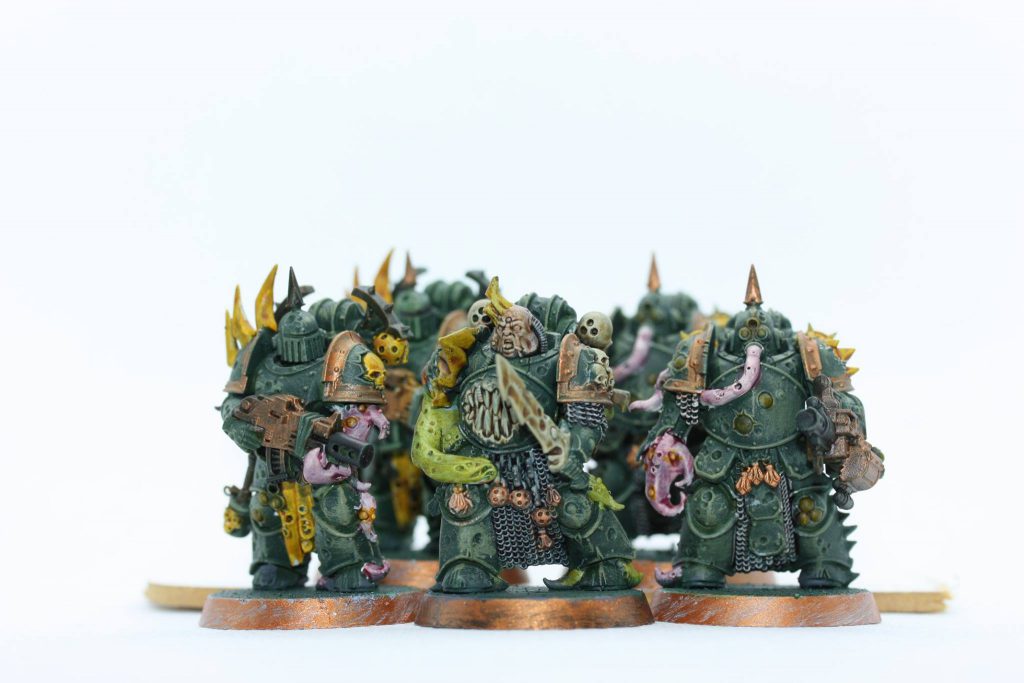
The Ferrymen
The Ferrymen kind of lack a real strong mechanical identity but they have a couple of very solid rules to draw from. On Droning Wings is the big reason to take them, and can make for some nasty surprise plays.
- On Droning Wings (1 CP) – Use this in your Command phase. Pick a FERRYMEN FOETID VIRION model in your army, then pick one of that model’s Aura abilities. Until the start of your next Command phase, add 6″ to the range of that aura ability (to a maximum of 12″). This is pretty decent, and combines really well with the Revolting Stench-Vats Relic on a Foul Blightspawn to create an impromptu 12″ no-charge radius, or on a Plague Surgeon to get 9″ of 6+ ignore wound rolls. It also works well with the Warlord Traits that grant auras. It’s a really versatile ability and it’s rare that you’ll field a Death Guard army without some of the guys this works with, but it won’t do as much as you hope it will. C+
Don: This is an interesting pick but requires you to telegraph your hand to your opponent. It is extremely proactive and can be largely ignored. Even with Revolting Stench Vats being 12″, most opponents will just shoot you or charge in such a way that it will not matter. It isn’t bad, but it is not strong enough to be your only reason for taking this plague company. - Warlord Trait: The Droning (Contagion) – While an enemy unit is within Contagion Range, at the start of your opponent’s Movement phase, halve that enemy unit’s Move characteristic until the end of the phase. This is a nasty ability and can be flat out devastating in the right circumstances, holding armies in place or preventing units from falling back if you’re fighting in difficult terrain. It’s a particularly great candidate for the Flash Outbreak Stratagem and is great on either Mortarion or a Lord of Contagion. Your biggest challenge will be getting into position to do the maximum damage with it early in the game. A
Don: This contagion is situationally game breaking. Movement is the most powerful stat in the game. Being able to cut that number in half means that you will cause your opponent to fail to do what they are routinely able to do with their mobility. - Relic: Ferryman’s Scythe – A replacement for the Manreaper, the Ferryman’s Scythe lets you make 3 attacks instead of 2 for each attack made with the Scythe profile of the weapon. This is alright, if unexciting. Being able to make 15 attacks with a Lord of Contagion is pretty funny, but you may find yourself better off taking other relics instead. If you could take this on a Deathshroud Champion, it’d be money. C
Don: Another weapon that suffers from the “Not as good as other relics” syndrome. It is not bad, but man the other relics are just better. Take this only if you are really interested in a narrative play with a Lord of Contagion.
Mortarion’s Chosen Sons
The Chosen Sons are all about making better plagues and contagions to make more potent weapons, and their abilities largely reflect that. Because they have buffs that buff plaguespurt gauntlets, they can be a fun pick for armies that run heavy on Deathshrouds.
- Plague Brewers (1 CP) – Use in the Shooting phase, when a MORTARION’S CHOSEN SONS unit from your army is selected to shoot. Until the end of the phase, Plague Belchers, Plagueburst gauntlets, and plague spewers models in that unit are equipped with have a damage characteristic of 2. This can be pretty nasty on a big unit of Deathshrouds, where tossing out 7D6 hits of 2-damage pus can more than make up for the guns’ low strength and AP. B+
Don: This stratagem is not ideal with the storm shield marine meta. However, if we look at armies that don’t sit on 2+ saves, such as tyranids, orks, daemons, necrons, etc. you will quickly see how plaguespurt gauntlets with this stratagem skyrocket in effectiveness. This is especially true when mixed with the Arch Contaminator warlord trait. - Warlord Trait: Nurgle’s Fruit (Contagion) – While an enemy unit is within Contagion Range, each time an attack is made with a friendly MORTARION’S CHOSEN SONS model against that unit, the target does not receive the benefits of cover for that attack. This will turn off the save bonuses for light and hard cover as well as the modifier to hit for shooting at a unit This is a pretty solid ability and a boon for an army that struggles to generate high AP shooting. The big downside is that the range limitations make it hard to take full advantage of the effect and you seldom see Hard Cover in games to make it work in the Fight phase. C
Don: I don’t think that a list which is built to support Mortarion’s Chosen Sons is going to have enough shooting with fast enough units to make this worth much. It will be useful if your meta utilizes Hard Cover, but that seems to be fairly scarce on tables right now. - Relic: Vomitryx – A replacement for the Foul Blightspawn’s Plague Sprayer, the Vomitryx is now a solid upgrade on the default weapon, sporting an Assault 7 profile over Assault D6, which is a very nasty upgrade and if you’re running Mortarion’s Chosen Sons, you’ll want to include this. The problem is that you’ll want to include it after Revolting Stench-Vats.. A
Don: If you are running multiple Foul Blightspawns than this relic is really good. It is not as useful as Revolting Stench-Vats, but it is very good and will kill off whole squads of primaris on its own.

Stratagems
Compared to the paltry set they had in most of 8th edition, Death Guard now have a glorious FOUR PAGES of Stratagems to work with. And most of them are pretty good!
Battle Tactic Stratagems
- Trench Fighters (1 CP) – Used in the Fight phase when a Plague Marines unit fights. Until the end of the phase, when models in that unit fights, if they have a plague knife, they get to make 1 extra attack with one (not each) of its plague knives. This is a strong Stratagem – it combines with Nurgle’s Gift, the base 2 attacks that Plague Marines have, and the AP-1 boost that plague knives got to make Plague Marines a real threat in melee. It’s also pretty cheap for a cost of only 1 CP. Use this to punish people who think the answer to your minimum-sized squads of Plague Marines is “charging them.” B+
- Creeping Blight (1 CP) – Use in the Fight phase, when a Death Guard unit fights. Until the end of the phase, when attacking with a plague weapon, an unmodified wound roll of 6 causes that attack to have AP-4. This can be a pretty nasty effect, especially against vehicles or units without an invuln, but really requires a high volume of attacks to make it worth it and it’s a nonbo with abilities that turn hit rolls of 6 into auto-wounds. For this reason it combos well with Trench Fighters, where the extra attacks make pushing through more AP-4 more likely. This is also one of the few stratagems that works on Mortarion, though the times you’d actually use it are really rare. It’s more helpful on a big unit of Deathshrouds, who are using their reap profiles to double up on AP-1 attacks. It’s a little more useful in a post-AoC world, but you often won’t have the CP to spend on it. B-
- Fire Fever (1 CP) – Use in the Shooting phase when a Death Guard Helbrute shoots. Until the end of the phase you can only target one enemy unit but you get +1 to hit and wound when shooting that unit. If Death Guard Helbrutes were any good this would be a very good stratagem. If you could take a Helbrute with two ranged weapons and a fist, this’d be solid. As-is, it’s only OK. B
- Vermid Whispers (1 CP) – Use in the Shooting phase or Fight phase when a Death Guard Terminator unit from your army shoots or fights. Until the end of the phase, that unit gets +1 to its to hit rolls. This is exceptionally good, great on Blightlords and it works on your terminator armored characters. It’s also very good for negating the -1 to hit from power fists or the Cleave mode on the Manreaper or Plaguereaper. A
- Haze of Corruption (2 CP) – Use in the Fight phase when a Death Guard CORE unit fights. Until the end of the phase each time an enemy model is killed by an attack from a model in this unit, excess damage from that attack is not lost and is suffered by another model in that unit (they don’t get a save). This continues until no excess damage remains. This is basically a Stratagem to give you what flails used to. Previously this Statagem wasn’t much to write home about, but now that Plague Marine weapon upgrades are free, there’s a lot of value here on units that run cleaver/mace/flail, since you’re talking about 12 multi-damage attacks and the ability to spread 10-12 damage across a unit. This can also be OK on Helbrutes and Contemptors, where you can pile on multi-damage attacks and plow through a unit with spillover damage from a Power Scourge or Chainfist. B+
- Eternal Hatred (2 CP) – Use in the Shooting phase or Fight phase, when a BUBONIC ASTARTES shoots or fights. They get +1 to their wound rolls until the end of the phase. This is the replacement for Veterans of the Long War, with a significant cost increase and a much narrower target focus. It’s still very good even at the higher cost, and is great against bigger targets like Custodes and Knights, where you might not already be wounding on a 2+. It’s a great way to help mitigate the Death Guard’s relative lack of higher-strength shooting and weapons. A
- Mutant Strain (1 CP) – Use in the Fight phase, when a unit of Poxwalkers fights. Until the end of the phase, whenever they roll an unmodified 6 to hit they do a mortal wound in addition to their normal damage, and whenever they roll an unmodified 1 to hit they take a mortal wound. Poxwalkers are relatively unimpressive on their own but this Stratagem can make them into a force to be reckoned with, since on average a unit of 10 will throw out 2-4 mortal wounds and a unit of 20 will dish out 5-7. Sure, you’ll take just as many but you’ll shrug off 1 in 6 of those and also who cares if you lose a few 5-point Poxwalkers? You’ll get some of them back with your kills anyways. A
Epic Deed Stratagems
- Diseased Effluents (1 CP) – Use in your Command phase. Pick a non-Daemon Death Guard character model in your army and one enemy unit within Engagement range of it. Your model takes 1 mortal wound and then you roll a D6; on a 2+, the enemy unit takes 2D3 mortal wounds. If that enemy is a non-Vehicle Character, they take D3 mortal wounds instead. This can be a nasty little trick to throw out some extra mortal wounds, particularly when you’re stuck in against some units that are really hard to remove like Bladeguard Veterans where throwing out a few mortal wounds can clear out a model or two. That said, there’s a chance it totally fails, which isn’t great. Also having to use it during your Command phase isn’t great, since it requires you be still locked in combat. The timing on it – before primary objectives are scored – is great, though. B
Don: I’d give it an A. This stratagem will win you games. The only reason I do not have it as an “S” tier is that you can fail on a roll of a 1. It frees up movement and it can go off BEFORE you score your objectives. - Unclean Machine Spirit (1 CP) – Use in your Command phase and pick a Death Guard Machine Spirit model (i.e. a Death Guard Land Raider) from your army. Until the end of your next Command phase that model is considered to have full wounds remaining for the purposes of determining what profile to use. This is… fine, but you’ll never use it because you won’t ever be using Land Raiders. C
Don: This is limited to units that we don’t use competitively, and even when you use them you will not spend your CP on this. - Befouled Incubators (1 CP) – Use in the Fight phase, when a Death Guard Character fights. For the rest of the phase, each time that character’s attacks destroy an enemy model, roll a D6; on a 3+, that enemy model’s unit suffers 1 mortal wound after your model has resolved all of its attacks, to a maximum of 3. Another of the few Stratagems Mortarion can use, this can be helpful for pushing through a few extra wounds when you’re using scything attacks against a large unit, but it’s going to be very situational. C
Wings: I’d probably push this up to a C+, it’s a fine thing to have in your back pocket to let a Lord of Contagion finish off a guard squad or something. - Release the Toxins (2 CP) – Use in your Command phase. Pick a Death Guard Character who was equipped with a Relic of Decay at the start of the battle. Roll a D6 for each unit within 7″ of that model: On a 2-5 that unit suffers 1 mortal wound and on a 6 that unit takes D3 mortal wounds. You can only use this once per battle per unit. This is pretty decent, and a great way to poop out some extra mortal wounds at everything around you in a pinch. It can be really helpful for pushing that last wound through, it has a solid range, and if you position correctly it can do quite a bit of damage. And as with Diseased Effluents, it happens before scoring. B
- Eruption of Filth (1 CP) – Use in any phase when a Death Guard Character model is destroyed. Instead of using any rules that are triggered when it’s destroyed, roll a D6 for each non-NURGLE unit within 3″; on a 2-5 that unit takes 1 mortal wound and on a 6 that unit takes D3 mortal wounds. This is a solid way to take some models out with you when your character dies and if you’ve already been doing damage or pushing out wounds with Release the Toxins or killed your character with Diseased Effluents you can really take a lot of models with you. You can use this with Mortarion but it’s not really worth it. C

Requisition Stratagems
- Champion of Disease (1 CP) – Use before the battle to give a BUBONIC ASTARTES model in your army with the word ‘Champion’ in their profile one of the Reaper of Glorious Entropy, the Plague Skull of Glothila, Plaguebringer, or the Supparating Plate. You can use this twice in a Strike Force mission and each relic has to be unique (and you can’t give a model two relics). This is a surprisingly useful Stratagem and the most useful application of it is likely giving a Plague Skull of Glothila to a champion, giving you a protected model who can huck the Plague Skull at enemies to do a solid number of mortal wounds. It’s high variance, but every now and then it’ll fully delete an important unit. The Reaper of Glorious Entropy and Plaguebringer can both be interesting as ways to bump your damage output and then have it roll over with Haze of Corruption. A
- Gifts of Decay (1 CP) – Your standard Stratagem to get extra Relics of Decay. You’ll use this in many of your games because the Death Guard relics are pretty good. A
- Plague-Chosen (1 CP) – You can give a second character a Warlord Trait. The Death Guard have some good characters and good Warlord Traits, and you’ll likely use this in most of the armies you build as well. A
- Grandfatherly Influence (1 CP/2 CP) – Use when you’re mustering your army to upgrade a unit of Death Guard Chaos Spawn in your army. They get +1 Toughness and gain Disgustingly Resilient. If the unit is 3 or fewer models, this costs 1 CP, otherwise it costs 2. This makes your Spawn T6 and makes removing them from the board considerably tougher. Spawn are a great way to fill leftover points in the army as a fast unit that can move through walls and hold backfield objectives or threaten weaker infantry that get too close. If you’re taking more than one spawn, you should be thinking about using this Stratagem to boost them. It’s a solid deal for 6 and a steal for 3-model squads, but you really can’t afford to invest CP into Chaos Spawn these days. C
Strategic Ploy Stratagems
- Sickly Corrosion (2 CP) – Use in the Fight phase or Shooting phase when a Death Guard model from your army makes an attack with a Plague Weapon that scores a hit against an enemy unit. Until the end of the turn, each time an attack is made by a Death Guard model against that enemy unit, re-roll a wound roll of 1. This can be a pretty powerful effect, but it’s somewhat limited in that it does nothing for your army’s plague weapons and the 2 CP cost is pretty high. Still, you can get a lot of value out of this by priming a target with the mortar shots from a Plagueburst Crawler, then popping this to get re-roll 1s to wound on something like Contemptor’s Volkites or the Multi-Meltas on a trio of Myphitic Blight Haulers. It can also be something you use to get more value out of bolters or combi-bolters, where you can turn use a unit’s Blight Launcher to trigger the re-roll 1s to wound for the rest of the unit. B
- Belching Fumes (1 CP/2 CP) – Use at the start of your opponent’s Shooting phase and pick a unit of Myphitic Blight-Haulers. Until the end of the phase each time an enemy model makes an attack with a ranged weapon against the unit, reduce the number of attacks made by that weapon by 1 (to a minimum of 1). If the unit is 2 or fewer models, this costs 1 CP, otherwise it costs 3. This is a very good effect and can be really helpful if you’re up against something like Retributors, where you’re immediately cutting half their effectiveness. It’s a strong effect for protecting your Blight-Haulers and making them as annoyingly resilient as possible. A
Don: I use this every game and man does it make your opponent cringe at just how effective it is. Expect your opponent to question you on what it does because it will make their attack bikes, retributors, and even bolters lose a massive bit of their firepower. - Blight Bombardment (2 CP/3 CP) – Use this in your Command phase if your Death Guard Warlord is on the battlefield. Pick a spot on the table and put a marker there. At the start of your next Command phase roll a D6 for each unit within 6″ of the center of the marker and add 1 if that unit is INFANTRY and subtract 1 if it’s a CHARACTER. on a 2-6 that unit takes D3 mortal wounds and on a 7+ it takes D6, then you remove the marker. If your warlord is a Lord of Virulence this costs 2 CP, otherwise it’s 3. This is a tweaked version of Orbital Bombardment that can get discounted and is a little less reliable but has higher damage upside. It’s pretty much too expensive to see much use and making it work is really, really, particularly given how mobile most armies can be. D
Don: You will not use this Stratagem every game, but when you opponent cuddles up on a piece of terrain you should punish them for it or scare them in to fleeing from it. - The Dead Walk Again (1 CP) – Once per game per unit you can use this in your Command phase to pick a Poxwalker unit and roll seven D6; for each 3+ one of that unit’s destroyed models comes back with 1 wound remaining. Models added back can be put in Engagement Range of units for which the Poxwalkers were already in Engagement Range. This is a very strong Stratagem – on average you’ll get back 4-5 models doing this and how you place the models can let you do things like move yourself closer to objectives, rework the math on Objective Secured totals to deny an opponent an objective on their turn, or shift your unit toward a unit they plan to charge. There are a lot of ways to use this and if you’re taking Poxwalkers you’ll likely end up using this Stratagem. A
Don: This stratagem will win you games by bringing up pox walkers on to an objective during your command phase before you score your primary points. - Dark Cravings (1 CP) – Used in the opponent’s Charge phase. Pick a Foetid Bloat-Drone in your army. Until the end of the phase if it’s within 6″ horizontally and 5″ vertically if any enemy units, it can do a Heroic Intervention as if it were a character and move up to 6″ instead of 3″. This is a very, very good boost on Fleshmower Drones, allowing them to close large distances in the Fight phase to help out nearby units, forcing opponents to deal with much more dangerous threat ranges. It also makes it much harder to effectively fall back from one. Hell, it’s even good on shooty bloat-drones as a way to stop shenanigans or tie up units that don’t want to be charged. A
- Daemonic Gluttony (1 CP) – Used in the Fight phase when a DEATH GUARD DAEMON ENGINE fights. Until the end of the phase when they destroy an enemy model with an attack, they regain 1 lost wound to a max of 3 per phase. This is a helpful way to heal a Fleshmower Bloat-Drone or Defiler if you know you’re going to be in combat with infantry but it’s largely situational. Still, taking a Bloat-drone that held on to its last 1-2 wounds back up to 4-5 can be hilariously demoralizing for opponents. B
- Cloud of Flies (2 CP/4 CP) – Use at the start of your opponent’s shooting phase and pick a BUBONIC ASTARTES INFANTRY unit in your army. Until the end of the phase, that unit can’t be targeted by enemy units unless it’s either the closest eligible target or within 12″, and it loses the BODYGUARD ability if it had it. On Terminators this costs 4 CP, otherwise it costs 2. This is an incredibly expensive Stratagem – at most you’re going to use it once per game. It’s really for when you absolutely need to protect a small unit on an objective that’s caught in the open and even then you need a visible screening unit to make it work. It’s particularly helpful for protecting characters who get caught/shot out of protection and avoiding losing valuable force multipliers or giving up Assassination points. C
- Break Their Spirits (1 CP) – Use in the Fight phase when a Death Guard Terminator destroys a model in an enemy INFANTRY, BEASTS, or SWARMS unit. That unit gets -4 Ld until the end of the turn. It takes a lot for Leadership effects to be worth using and this one absolutely goes that extra mile and makes itself worth using. Dropping a unit -4 Ld after a single model death immediately puts them at a -5 modifier when taking a morale test that turn, which means that Space Marines with a sergeant will fail that roll half of the time unless they’re veterans. This also combos with a lot of other abilities, such as the Poxmonger’s Sanguous Flux Contagion or the Noxious Blightbringer’s Tocsin of Misery aura. Or both, if you want to make things really nasty. Great for scoring extra points for Fleeing Vectors. A
- Flash Outbreak (2 CP) – Use in your Command phase and pick a Plague Company unit with the Contagions of Nurgle ability in your army. Until your next Command phase, that unit gets all of the Contagions that another model in the same Plague Company on the table has, and every unit in your army counts the round number as being 1 higher for the purposes of Contagion range. So you can use this to do something like give a Bloat-Drone your Warlord’s Ferric Blight contagion for a turn and get an early shooting boost as you move it close to a key target. Also boosting your army’s contagion range by 1 round is a huge benefit, especially on rounds 2/3 when you can jump to 6″/9″. Errata fixed this Stratagem so it doesn’t work on some of the Forge World units it used to but the army-wide boost makes it a very solid tool to have. A
- Putrid Detonation (1 CP/ 2 CP) – Use when a Death Guard vehicle is destroyed. Skip the roll to see if it explodes – it does so automatically. This costs 1 CP if the vehicle had 9W or fewer, 2 CP otherwise. You won’t use this all the time but it’ll be pretty obvious when you want to use it. It’s a very helpful Stratagem to have in your back pocket. Just remember to note which of your vehicles will hurt your own units and which have Putrid Explosions that don’t affect NURGLE units. A
Wargear Stratagems
- Foul Smokescreen (1 CP) – Use in your opponent’s Shooting phase when a Death Guard Smokescreen unit (a Rhino, Predator, Land Raider, or Defiler, plus some of the Forge World tanks) is picked as the target of an attack. For the rest of the phase, attacks made against that unit get -1 to hit. This is a good buff, and it’s great that you can wait to pop it until you’re already being shot, ruining at least one unit’s day. It’s good for keeping your Rhinos and Defilers around. Well, it probably won’t keep your Rhino around so much as require an opponent to put more shooting on it than they would have, but that’s a win most games. B+
- The Blightening (1 CP) – Use in your Shooting phase and pick up to three Death Guard models in your army. Until the end of the turn their Plague weapons with the Grenade type lose Blast, become Type Pistol 6, and each time a model makes an attack with one of those weapons against an enemy unit in Engagement range, the attack automatically hits the target. Plague Marines don’t come with bolt pistols and so this allows them to get some extra damage in during the Shooting phase when they’re locked in with an enemy unit. Turning the grenade type to Pistol means you can pick three models in the same squad with this to max out your grenade output, and still throw a fourth grenade regularly. This is going to pay off the most when you pair it with a Biologus Putrifier, who bumps up the AP and damage of your grenades. It’s situational, but being able to dump out 18+ S4 AP-1 D2 hits with a squad and the Putrifier is pretty damn good. This gets extra mileage by combining with most of the army’s special grenades, like the Orb of Desiccation or the Death’s Head Grenade. It does not combo with the Plague Skull. A
Don: This stratagem will burn you out of combats against armies that rely on minimum-sized units that are pretty common these days. It will also kill off hordes of units if they tie you up too. It is even good against units that you are not engaged in combat with. Remember that you can still shoot your plasma/bolt/injector pistol at the same time as this makes your “plague weapon grenade” a pistol, removing the grenade restriction on it. - Virulent Rounds (1 CP) – Use in the Shooting phase, when a Death Guard Core unit is picked to shoot. Until the end of the phase bolt weapons that unit are equipped with have the Plague Weapon ability. This gives you re-rolls on 1s to wound whenever you need it and it’s a great way to boost a unit of Plague Marines or Blightlords about to open up with their bolters and you need to max out their effectiveness. It also combos with several other effects, such as Overwhelming Generosity, the Arch-Contaminator Warlord Trait, and the Master of Destruction aura on the Lord of Virulence. It’s a solid ability but you won’t use it all the time and there are other ways to get re-rolls of 1 to wound in the army. Does its best work with large units of Blightlords. B
- Overwhelming Generosity (1 CP) – Use this Stratagem in the Shooting phase when a Death Guard unit is picked to shoot. Add 6″ to the range of Plague weapons models in that unit are equipped with. This can be really helpful for extending the range on a squad of Deathshrouds, bumping them to 18″ with their puke flamers, and it combines with Virulent Rounds to give you 30″ plague bolters (while also bumping the range on the Blight Launchers). It can also be used on a Plagueburst Crawler in a pinch, giving you pretty much infinite range on its heavier plague weapons. It’s also great on a Foul Blightspawn to get 18″ range on his Plague Spewer. It’s another Stratagem you won’t use often, but it’ll create a lot of value when you do. B+
- Disgusting Force (1 CP) – Use in your Shooting phase when a Plagueburst Crawler is picked to shoot. Until the end of the phase its mortar becomes Damage 3 and after it shoots, pick one enemy unit hit by one or more of the mortar attacks this turn. Roll a D6 for each other non-NURGLE unit within 3″; on a 4+, that unit takes 1 mortal wound. This is really, really solid and it’s something you’re going to use almost every time you shoot with a Plagueburst Crawler. The splash damage is a great bonus but spending 1 CP to increase your damage output by 50% is very much worth it, though note that half the time this Stratagem costs 2 CP as you’ll want to combine it with a Command Re-Roll to maximize your number of shots. Good for taking on big targets and scoring a few extra wounds and it won’t hurt your own units if they happen to be nearby. A
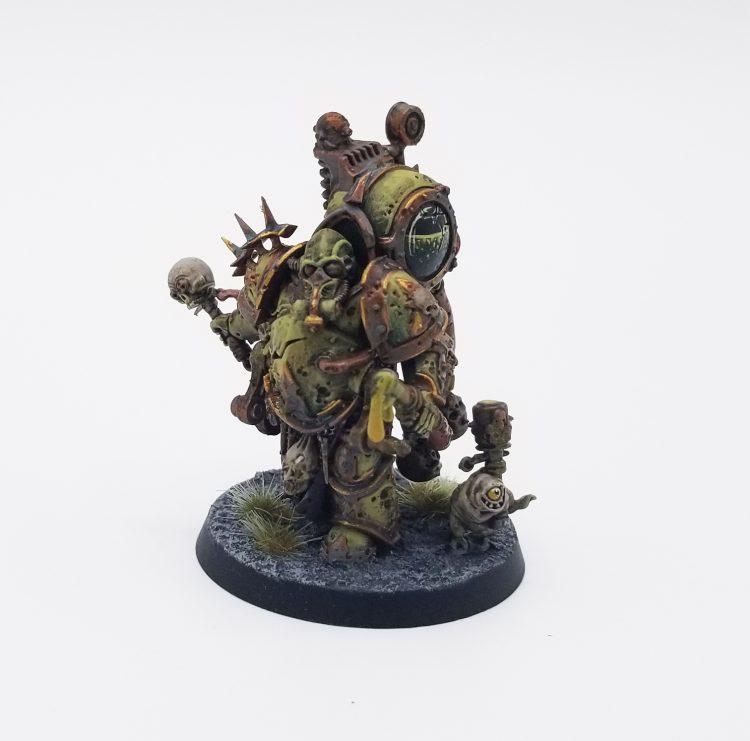 Credit: Robert “TheChirurgeon” Jones
Credit: Robert “TheChirurgeon” JonesDeadly Pathogens
Armies with a Death Guard Detachment (excluding Auxiliary Support, Super-heavy, and Fortification detachments) get access to Deadly Pathogens, upgrades for Death Guard Characters and Bubonic Astartes champions that improve a single plague weapon the model is equipped with (it can’t upgrade Grenades or Relics). Doing this increases the cost of the model by 10-20 points and raises its power rating by 1 but gives the weapon +1 Strength and an upgrade chosen from a list. An army can’t include two characters with the same Deadly Pathogen upgrade.
Deadly Pathogens are… well, they’re a cool idea. But they suffer from the fact that there just aren’t that many good plague weapon options for you to pick from – only the Lord of Virulence, Foul Blightspawn, and Deathshroud Champion have ranged plague weapons to begin with and the benefits themselves aren’t all that exciting, particularly when applied to melee plague weapons. The best of them are Acidic Malady, Viscous Death, or Virulent Fever, but many of them are too expensive to use. With the Nephilim points update, they’ve all dropped 5 points in cost, which is a big boon, but really just makes the decent options better rather than making previously bad options playable. You don’t need any of these, but some of them are a good way to spend your last 10-15 points.
- Acidic Malady (+15 points) – Improve the AP of the weapon by 1. This is particularly solid on the Lord of Virulence, where jumping up to AP-2 on the Twin Plague Sprayer and making it S6 are a very solid boost. It’s less useful on a Blightspawn, where you’re already rocking AP-3. It can also be helpful for getting better Scythe attacks on a Manreaper. At 15 points it’s probably still too expensive, but with Armour of Contempt it’s become a borderline upgrade. B-
- Explosive Outbreak (+15 points) – Unmodified hit rolls of 6 cause 1 additional hit – this isn’t cumulative with the ability from the Tollkeeper Relic. This does nothing for you if you’re using one of the ranged plague weapons, so the only area it applies is to melee plague weapons. It’s OK on a Manreaper, but it’s never going to be worth paying 15 points for. D
- Virulent Fever (+15 points) – Each time you make an attack with this weapon, an unmodified wound roll of 6 causes 1 mortal wound in addition to the normal damage. This is OK and does the best work on a Lord of Virulence, where you’ll get the most opportunities to generate mortal wounds, but it’s not bad on a Deathshroud Champion who can benefit from Arch-Contaminator to get full re-rolls. At 15 points it’s not a bad way to spend your last 15 points. C
- Befouling Runoff (+5 points) – Enemy units don’t get the benefits of cover against attacks from this weapon. Even at 5 points this is probably the least useful of the Pathogens. It doesn’t do anything for you against Dense Cover because the weapons it would go on automatically hit, Hard Cover is rarely used so it won’t matter most of the time on melee weapons, and the rest of the time you’re going to be wondering why you didn’t just spend the 10 points to get +1 to your AP for the same benefit. D
- Unstable Sickness (+10 points) – Each time an attack from this weapon destroys an enemy model, roll a D6; on a 4+ that model’s unit suffers 1 mortal wound, up to a max of 3 per turn. This model can’t be selected for the Befouled Incubators Stratagem. This can have some play on a Lord of Contagion, though Virulent Fever is probably a better play on the whole. C
- Corrosive Filth (+15 points) – Add 1 to the damage characteristic of the weapon when it attacks a VEHICLE. If this didn’t have the VEHICLE restriction it’d be amazing, but with the restriction it’s merely very solid. It’s an OK upgrade on a Lord of Virulence’s Twin Plague Sprayer or a Foul Blightspawn’s Spewer as a way to give them extra punch against vehicles, and throwing it on a Deathshroud champion or Lord of Contagion for a better melee option against knights isn’t bad, either. At 15 points this is much more reasonable to pay for. B
- Viscous Death (+5 points) – Each time you roll to determine the number of attacks made with this weapon you can re-roll the result. This is my favorite of the bunch, and really wants to go on a Foul Blightspawn, where being able to re-roll your D6 shots really helps smooth the variance on the gun. At 5 points it’s a steal and basically going to go on your Blightspawn whenever you take him, in part because improving him to S8 is also a big boost. A-
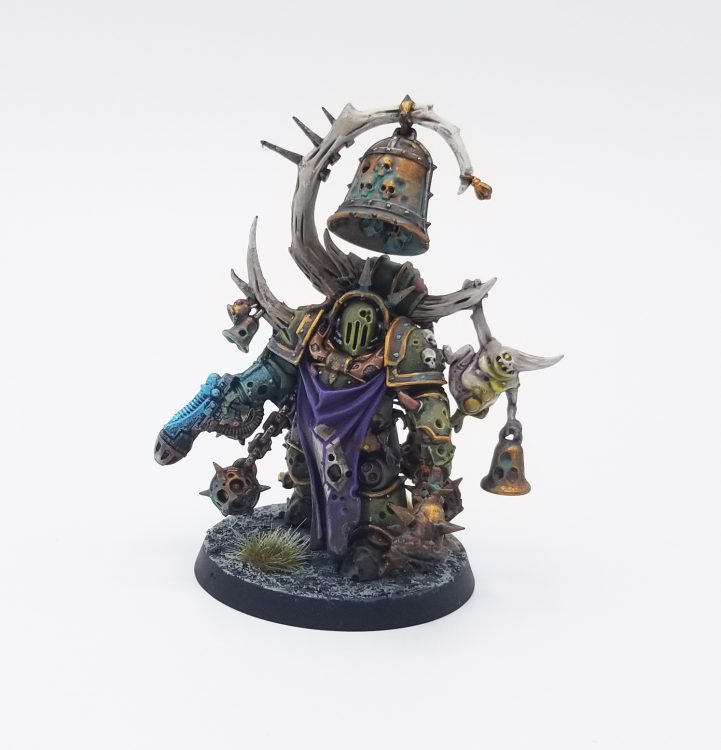
Relics
The Death Guard don’t have a lot of relics, but the ones they have are really good. Almost every one of these is useful, and many competitive armies will spend CP to bring a second or third relic, even in Nephilim. CP spent here is almost certainly going to generate more value than CP spent on one-off Stratagems in-game.
- Reaper of Glorious Entropy – This replaces a Manreaper or Plaguereaper with one that’s Sx2, AP-3, 3 damage and does a mortal wound each time you roll an unmodififed 6 to wound in addition to the regular damage. It doesn’t have a scythe mode, so it’s basically a souped-up Plaguereaper that does extra mortals and doesn’t give you -1 to hit. It’s perfectly serviceable but it’s not going to be what you spend a Relic slot on. It does have some extra utility on a Deathshroud Champion however, where getting 3 damage is a boost and still being able to hit on a 2+ is a big help. C+
- Plague Skull of Glothila – This souped-up grenade can be thrown once per battle at the end of your Movement phase. Pick a unit within 6″ of the bearer and roll 7D6; for each 4-5 that unit takes a mortal wound and for each 6 they take D3 mortal wounds. This is high variance as an effect but on average, this is going to do somewhere around 4-5 mortal wounds, which can be enough to wipe out an enemy character that got too close (note there’s no character targeting OR line of sight restriction on it). It’s possibly the best of the relic options you can put on a champion using the Champion of Disease Stratagem. There are games where you may not find a great target to use it on but it’s such a good effect that it’s worth finding room for it in most armies. Just remember to use it in the Movement phase, both because that’s helpful for taking down C’Tan and because opponents tend to get snippy when you try and lob it in the Shooting phase to delete one of their characters. A
- Daemon’s Toll – This goes on a Noxious Blightbringer and can be used once per battle at the start of the opponent’s Movement phase. Once used, pick an enemy unit within 6″ of the bearer – until the end of the phase, each time that unit is selected to Fall Back, roll a D6 and on a 2+ it can’t fall back and must Remain Stationary instead. Letting you effectively trap a unit in melee to protect your units is pretty good. The fact that it’s only once per game really hurts it. D
- Fugaris’ Helm – Adds 3″ to the bearer’s Aura abilities (to a max of 12″). This is a very solid ability and is probably best on a Plague Surgeon, where extending the 3″ aura for the 6+ ignore wounds roll is a great way to extend the surgeon’s area of coverage. It’s also solid on a Blightbringer, where you extend the ranges on three auras simultaneously. It also combines very well with the Arch Contaminator Warlord Trait. B
- Putrid Periapt – Goes on a Malignant Plaguecaster or Terminator Sorcerer and lets them know (but not cast…) an extra psychic power, plus once per battle after they manifest a power they can regain up to D3 lost wounds. This is OK but it’s not going to make the cut in most armies. B-
- Tollkeeper – Tallyman only. Gives the model the Tollkeeper Aura, which gives friendly <PLAGUE COMPANY> CORE units within 6″ the ability to score an extra hit every time they roll an unmodified 6 to hit with ranged weapons. This is a decent buff for a model that already buffs Plague Marines well. Remember that it also applies to grenades thrown by the unit. The money spot for this is on Volkite Contemptors, which also want the +1 to hit bonus from the Tallyman and use the Tollkeeper Aura to turn their 16 Volkite shots each into something more like 16-19 hits. This is pretty much the competitive use-case for Tollkeeper Tallymen. A
- Revolting Stench-Vats – Goes on a Foul Blightspawn. Gives him the Revolting Stench Aura, which makes it so enemy units within 6″ can’t use rules that let them fight first and they never count as charging. This is a great complement to the Blightspawn’s Putrefying Stink ability, giving you a way to shut down more than just a single unit within 3″ and punish enemy units that try and stay out of the Blightspawn’s Heroic Intervention range. Your Plague Marines can hit like a freight train in melee and this gives them a chance to do so before they lose models. If you can combine it with the Blightspawn’s 3″ “Fight Last” ability, you can override the abilities of any unit in the game to fight first and make them fight last. If you’re taking a Blightspawn, you need this relic on him. It’s one of the best relics in the game and makes whatever’s around your Blightspawn very difficult to charge profitably – just be sure to position your models accordingly. A+
- Supparating Plate – Gives the model a 2+ save and every time an enemy fights, after its attacks, if the bearer lost any wounds from those attacks, roll a D6′ on a 2+, the enemy takes a mortal wound. The biggest use of this is getting a 2+ save on a Daemon Prince, though you’ll often want to combine this with the Rotten Constitution Warlord Trait, which makes it even more expensive. It’s also a tough call to spend a CP on. B
- Plaguebringer – This replaces a balesword, plague blade, plague knife, or power sword with one that’s a S+2, AP-3, 2 damage plague weapon and every time it kills a model, that model counts as two destroyed models for morale purposes. This is a solid upgrade over all of those options, particularly because it gives you a 2-damage swing. It’s a good upgrade to consider on a Blighlord Terminator champion (where you can combo it with Break Their Spirits to score an easy -6 Ld for your first kill), or a Chaos Lord if you have 5 points left to spend on a Power Sword but probably won’t make the cut otherwise. B-

Psychic Powers: Contagion Discipline
The Contagion Discipline got an overhaul in the 9th edition codex, moving some powers around and adding a couple of new ones.
- Miasma of Pestilence (WC 6) – Pick one Death Guard unit within 18″ and until the start of your next Psychic Phase, each time an attack is made against that unit, subtract 1 from the hit roll. Even with the cap on hit modifiers in 9th, this is still a great power, and it’s particularly useful on Mortarion, who can’t benefit from dense terrain anyways. It also works in melee and it’s likely the only power you’ll double up on when you build your army. Be sure to give it to Mortarion if you take him so you can up his survivability even further. A-
- Gift of Contagion (WC 5) – Pick one enemy unit within 18″ and until your next psychic phase they’re -1 Strength. If you rolled an 8+ to manifest, they’re also -1 Attacks. This is just OK. It really should be considered to have a WC of 8 because the -1 Strength will matter so little – it’s basically just a factor when your marines are going up against S5/6 models, and that won’t be terribly often. The -1 Attack is pretty big, though. B-
- Plague Wind (WC 6) – Pick one visible enemy unit within 18″. Roll a D6 for each model in the unit. For each 6 you roll, the unit takes a mortal wound. If you roll a 9+ to manifest, they take mortal wounds on rolls of 5+. This is good against hordes, but bad otherwise. You basically need to hit units with 10 models to break even with Smite, and ideally you want 15 models or more to get more value out of your cast. Check our chart below for comparisons. The upside is that it’s a targeted mortal wound effect, but one that only helps you against hordes and those typically aren’t such a problem for Death Guard. C+
- Putrescent Vitality (WC 7) – Pick a friendly Death Guard INFANTRY unit within 18″. Until your next psychic phase they get +1 Strength and Toughness. This is a decent buff, good for getting your plague marines to S6 and wounding on 2+ with plague knives against T4 targets, and good on Possessed where getting to S6 will help them eviscerate T7 vehicles by getting to a 4+ to wound. The downside is that it’s not that useful most of the time and going from T5 to T6 just isn’t that big a deal. This combos in fun ways with the Fester Discipline’s Accelerated Entropy power, where it can push your Toughness mismatch to even greater heights and help ensure you get that D3+3 mortal wounds result. C+
- Curse of the Leper (WC 6) – Pick the closest enemy unit within 18″ and roll 7D6. For each die roll that exceeds the enemy unit’s Toughness, they take a mortal wound. This is a solid source of mortal wounds, particularly when you combine it with Nurgle’s Gift to get a +1 boost to your rolls. Against marines and other T4 targets you’ll average 3-4 mortal wounds per cast if they’re in Contagion range. The fixed nature of this means it’s going to be better than Plague Wind most of the time and better than Smite against Infantry, even if you’re only wounding on 5+. A
Don: You will usually get 3-4 mortals out of this against marines, 4-5 vs T3, and will burn through many tough units. This is not bad at all and I would not leave home without it. - Gift of Plagues (WC 6) – Pick a friendly Death Guard unit within 18″ and until your next Psychic phase it gets +6″ to the range of its Contagion abilities, to a max of 12″. This is pretty solid for extending the special plagues, and works very well on Mortarion, who can cast it on himself to push out a 12″ aura of The Droning or Gloaming Bloat, potentially dropping an army-wide debuff on a clustered enemy. It’s relatively easy to cast and has a solid benefit, even if you’re just using it to get an extra -1 Toughness on a unit near something before you shoot it. A
Don: This power will make your games significantly easier, especially if you are The Inexorable or The Wretched as their Contagions are things of beauty.
We looked at the probability behind Plague Wind, Curse of the Leper, and Smite in our Hammer of Math on the Death Guard psychic powers:
Curse of the Leper
Against T4 targets Curse of the Leper performs about even with Smite and against T3 or T2 targets it outperforms, making it important to get your targets within your own contagion range.
Plague Wind
Plague Wind really shines when you’re going up against units with 15+ models.

Warlord Traits
The Death Guard have six Warlord Traits, though note that if you take Mortarion he gets four of these, leaving you with only two to add to your army via the Plague-chosen Stratagem. You’ll still do it though, because these are some really good warlord traits. There’s only one that isn’t great (Foul Effluents), and even that one’s still OK.
- Revoltingly Resilient – Each time your Warlord would lose a wound roll a D6; on a 5+ that wound isn’t lost. Functionally this is a 50% increase in your model’s wounds. It’s amazing on Mortarion and solid on a Daemon Prince. It’s a great trait to have but it’s best on Morty. A
- Living Plague (Aura) – While an enemy is within 3″ they can’t be affected by aura abilities (except those from psychic powers) from units in your opponent’s army. This is also very, very good. Great way to shut off re-rolls against you or pesky buffs from nearby characters. A
- Hulking Physique – The Warlord gets +1 wound and each time an attack is made against them an unmodified wound roll of 1-3 for that attack fails, irrespective of any abilities that the weapon/model have. This is also very solid, and good on the Terminator Warlord options, where you’re more likely to be up against weapons that can get a 2+ or 3+ to wound them. It’s also seen use buffing up a key utility character, making them way harder to snipe out. A-
- Arch-Contaminator (Aura) – While a friendly <PLAGUE COMPANY> CORE unit is within 6″, they can re-roll wounds in melee for plague weapon attacks and they can re-roll wounds on ranged plague weapon attacks made against targets within 12″ of the attacking model. This is very good and combos with Virulent Rounds but it’s also just as good with Deathshrouds, whose plaguespurt gauntlets only have a 12″ range to begin with and a lower strength that makes this a great fit for them. This is great on a Lord of Virulence and it’s strong enough that you’ll want to consider not having Mortarion around just so you can put this on someone else. A
- Rotten Constitution – The Warlord gets +1 Toughness and when an attack with an AP of -1 or -2 is allocated to them, it becomes AP 0 instead. This used to be the jam on a Daemon Prince with the Supparating Plate, then it wasn’t thanks to Armour of Contempt, and now it’s back but harder to take because it costs a third of your CP to do and the Daemon Prince isn’t used often. It’s good if you’re taking him but it’s a big investment into a model whose best qualities are his re-roll aura and ability to do Warp Ritual. B
- Foul Effluents (Aura) – While an enemy is within 6″, roll a D6 at the end of your Movement phase; on a 4+ that unit takes 1 mortal wound. Probably the least good of the bunch but still very serviceable, this can be a good way to get extra mortals out, and in phases you normally don’t get to push them out. The coin toss nature of it stinks, though. C+
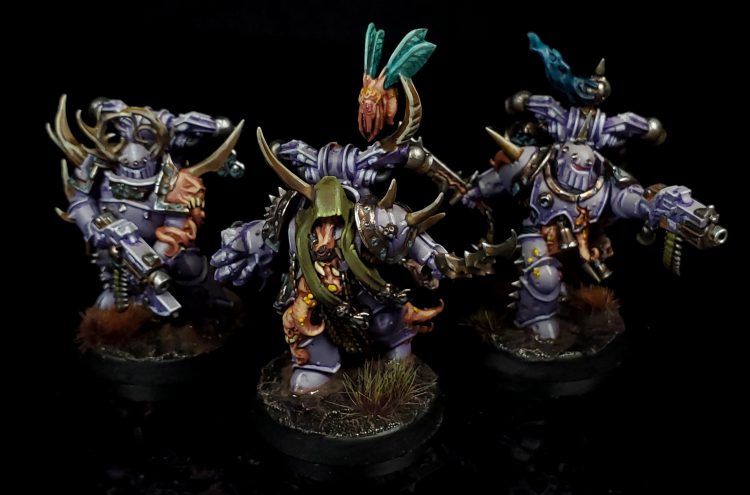 Plague Marines. Credit: Rockfish
Plague Marines. Credit: RockfishSecondary Objectives
Death Guard armies have access to three additional secondary objectives in War Zone: Nephilim, and they’ve all got some decent utility, though the stand-outs here are Despoiled Ground and Spread the Sickness.
Fleeing Vectors (No Mercy, No Respite) – Two ways to score here:
- Score 2 VP at the end of each player’s turn if 7+ enemy models where destroyed by attacks made by DEATH GUARD models from your army that turn. if 7+ of those enemy models were destroyed by attacks with plague weapons, you score an extra VP.
- At the end of the Morale phase, score 2 VP if one or more enemy units failed a Morale test that phase. If any of those enemy units had one or more models destroyed by plague weapons this turn, score an extra victory point.
This secondary got a boost in Arks from Nephilim, with the kill 7 VP bonus going to 2 from 1. That’s a huge boost and while I’d suggest this one is still very situational, it’s also very workable against horde armies where you are likely to wrack up lots of individual model kills with bolters and mortars. It’s extremely playable against Astra Militarum when you won’t get 12+ points for No Prisoners, and also has play against Daemons and Genestealer Cults. C+
Despoiled Ground (Battlefield Supremacy) – An endgame objective where you score 3 VP for each the following:
- 1+ Death Guard units form your army are wholly within your opponent’s deployment zone and 1+ Death Guard units from your army are wholly within your deployment zone.
- 1+ Death Guard units from your army are wholly within three different table quarters and all of those are more than 3″ from any other table quarter.
- One or more Death Guard units from your army are wholly within four different table quarters, and those units are more than 3″ from any other table quarter.
- You control half or more of the total objective markers on the battlefield and there are Death Guard units within range of each of those markers.
- Every objective marker on the battlefield is within range of one or more Contagion abilities that Death Guard units in your army have.
This got a boost in Arks of Omen, dropping the distance required from another table quarter from 6″ to 3″, making it a little easier. It’s still a really tough secondary to make work, particularly on Data-Scry Salvage and Tide of Conviction. It’s often seen (justifiably) as a “win more” secondary, in part because it requires you to be dominating half the table and that’s only likely to happen when you’re already dominating your opponent. It’s just not likely to get you more than 6-9 points most of the time – if that – and you’re better off planning on something like Behind Enemy Lines with teleporting Deathshroud units. D
Spread the Sickness (Shadow Operations) – This gives you a new action to perform called Spread the Sickness, which is also the only action that Poxwalkers perform. You can only do this once per turn on an uncontaminated objective you control and it finishes at the end of the turn. When it completes, if the unit doing the action has the Objective Secured ability, the objective is contaminated. Otherwise, you roll a D6 and on a 4+ the objective is contaminated. You score 3 VP for contaminating an objective in your deployment zone and 4 for contaminating one outside your deployment zone.
This is a massive improvement over the old version, which only ever gave you 3 VP and forced you to choose between rolling a 4+ and taking mortal wounds on a unit. This new version is great for 5-man Plague Marine squads and while it’s still nice to have Poxwalkers for, you no longer need them just to score any points at all. The 4-VP scoring outside your DZ is also great, making it difficult to score fewer than 11 points on this secondary objective most games. It’s by far the best secondary in the Death Guard toolbox, and you’ll take it almost every game, averaging around 10 VP per game as you get it on your home objective and the two closest. A-

The Units
The Death Guard have a relatively small unit selection but are fortunate in that the book has very few stinkers. In this section we’ll cover the faction’s units, offer thoughts on how to use them and loadouts, and some notes on playing with them. We’re not going to cover everything in exhaustive detail here, but will focus on the most competitive units and then a few specific Forge World units that are worth consideration.
HQ
The Death Guard have several HQs, though note that Chaos Lords, Lords of Virulence, and Lords of Contagion all have the LORD OF THE DEATH GUARD keyword and so you can only have one of them at maximum in a Death Guard Detachment. This means that if you want to have a second HQ and run a Battalion, it will need to include one of the psyker options – etiher a Sorcerer, Plaguecaster, or Daemon Prince.
Death Guard Daemon Prince
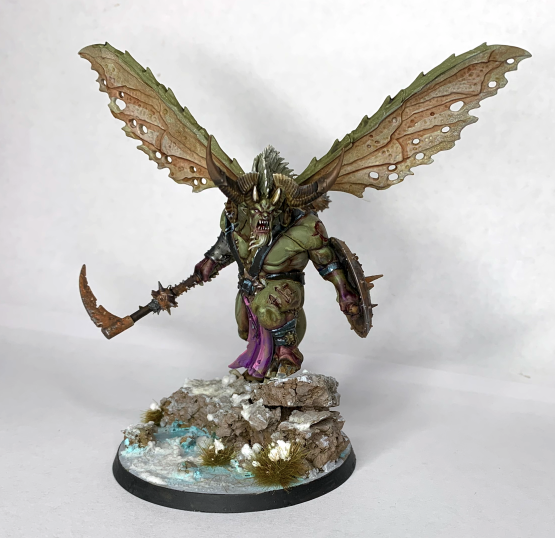
The Death Guard Daemon Prince is the most durable non-Mortarion character in the book, and one of the better fighters to boot. He comes with S7, T6 and 6A base, and all of his melee weapons give you decent multi-damage options, though it will seldom be worth taking the axe over the sword. With the release of Codex: Death Guard, these units have gotten a bit slower – they retained an 8″ Movement characteristic but now giving one wings will only boost your Movement another 2″ (while removing the Plague spewer as an option). Daemon Princes for Death Guard aren’t nearly the auto-includes that they used to be but they still pack a Lord of the Death Guard Aura to give re-rolls to nearby CORE units and they’re still tougher and faster than most of the army’s units, plus they give you a little extra psychic punch to boot. They can take the Supparating Plate and that boosts their durability considerably, and if you do that you will likely want to combine it with Rotten Constitution. This makes for a good combo with Hulking Physique to give them an extra wound and mitigate the fact that they’re T6 by making them only wound-able on a 4+.
Loadout-wise, you’re pretty much always going to opt for sword + talon though the wings are optional – the extra movement is nice but it’s easy to outrun your support with them and +2″ and FLY aren’t quite as necessary as you’d think. Because the Daemon Prince is faster, he makes a good target for the Gift of Contagion power and the special Plague Company Contagions. His biggest downside is that none of his melee weapons are plague weapons, significantly reducing your ability to combo them with other effects.
The problem with the Daemon Prince is that he’s not durable enough and it’s easy to overextend with him, getting him into situations where he’s able to be killed. It’s worth watching out as you build your list, as your Daemon Prince can become a juicy Assassination target if you end up with too many characters and while he’s one of your better fighters, he’s also going to disappoint you a lot thanks to his lack of built-in re-rolls. The net result is that the Daemon Prince offers more value as a meaty psyker option with an aura than a combat fighter and is probably better without wings or costly upgrades.
Typhus
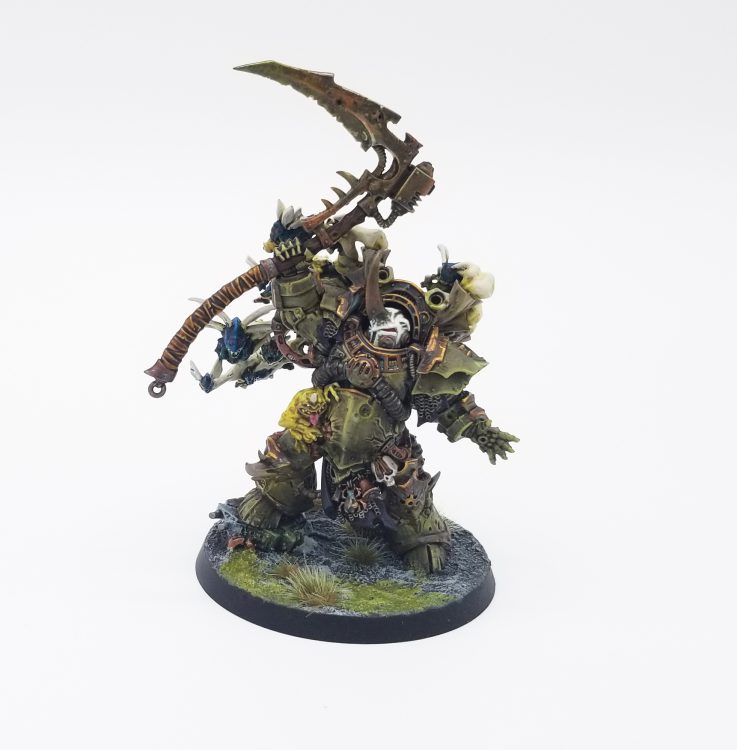
One of two named characters in Codex: Death Guard, Typhus combines the power, durability, and abilities of a Lord of Contagion with the psychic powers of a Malignant Plaguecaster and a few extra buffs to boot. While normally Typhus is locked into the Harbingers Plague Company, he can be part of any other Plague Company detachment without breaking that detachment’s units from carrying another Plague Company contagion. Typhus is a bit pricier compared to the Lord or Contagion but he keeps the Vector of Disease and Lord of the Death Guard rules and adds two psychic powers to the mix, a +1 strength buff to poxwalkers within 6″, and the Host of the Destroyer Hive rule which lets you pick an enemy unit within 6″ during your command phase and roll a D6; on a 2+ it takes D3 mortal wounds. That’s a lot of value! Unfortunately it’s not usually going to be worth it in a competitive list, where you really need those extra 50+ points to spend on something else, especially because the Harbingers are just not that great and Shamblerot stinks.
It’s also worth noting that despite what his rules say, Typhus still doesn’t technically work as intended in a mixed Plague Company detachment and so you should avoid using him outside of Harbingers detachments.
Death Guard Chaos Lords
Death Guard Chaos Lords finally got Toughness 5 in the new Codex but there aren’t a ton of compelling reasons to take a Death Guard Chaos Lord, particularly in terminator armor. The only non-Relic plague weapon Chaos Lords have access to is a balesword; really what they offer you is being the cheapest source of a Lord of the Death Guard aura (re-roll hit rolls of 1 for CORE units). That’s just enough upside to be playable in some lists but most of the time you’ll likely want to rethink your build. For 5 points they can take a power sword which you can replace with the Plaguebringer relic for a cheap 2-damage plague weapon that’s remarkably functional. You don’t want one of these as your only character, but in the right list they can provide value.
Lord of Virulence
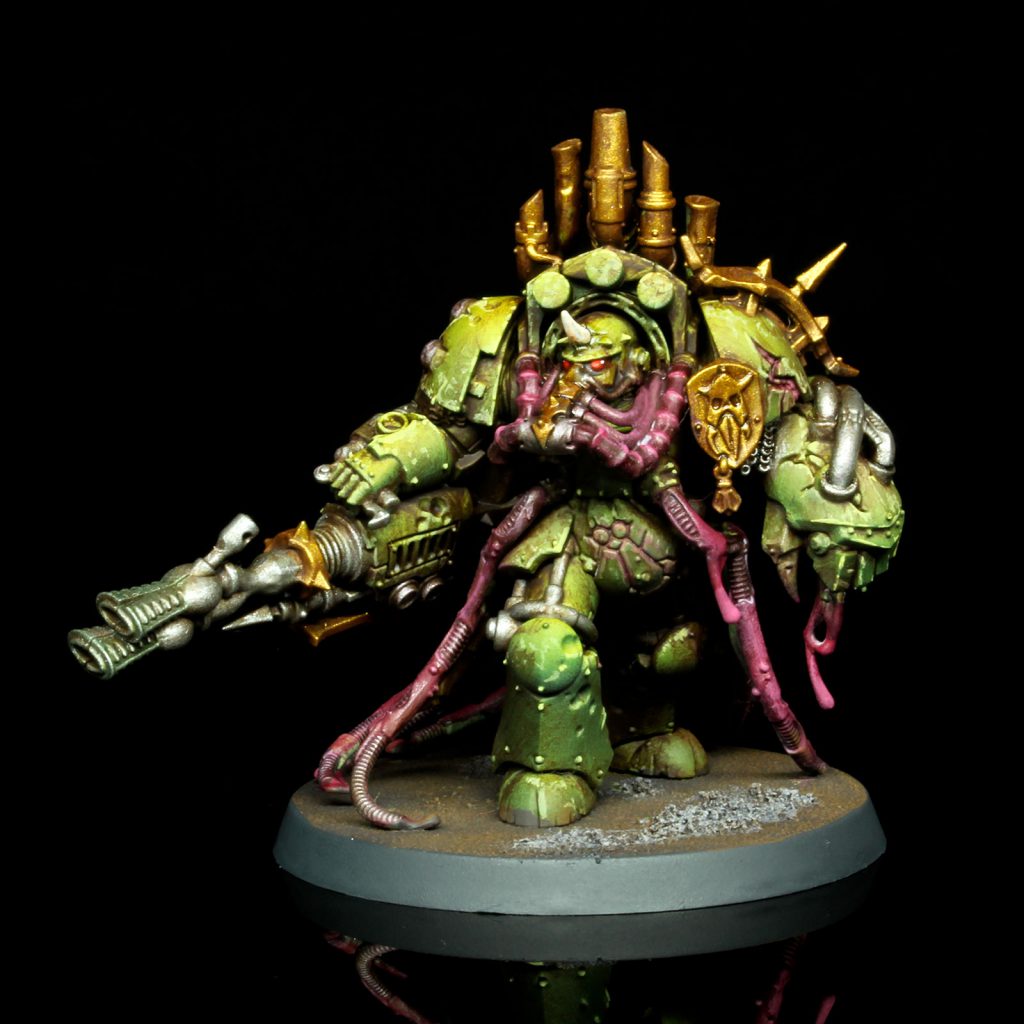
The new kid in town with the 9th edition Codex, the Lord of Virulence is basically the shootier cousin of the Lord of Contagion. Armed with a plague power fist and a twin plague spewer, the Lord of Virulence is mostly notable for sporting a double-barreled filth gun and having an aura that can improve the AP of ranged plague weapons for friendly CORE units within 6″ when they roll 6s to wound. This makes him a decent accompaniment to Deathshrouds, and he makes a good fit for the Arch-Contaminator Warlord Trait as a result. On the whole the damage output from the Lord of Virulence is only OK and his big problem is that the Death Guard CORE units just don’t have that many ranged weapons – your options here are the aforementioned Deathshrouds, who don’t really need the ranged boost, special weapons in squads, or popping off Virulent Rounds for a turn. How and when you use a Lord of Virulence depends on your army but he’s almost always going to accompany a unit of Deathshroud.
Lord of Contagion
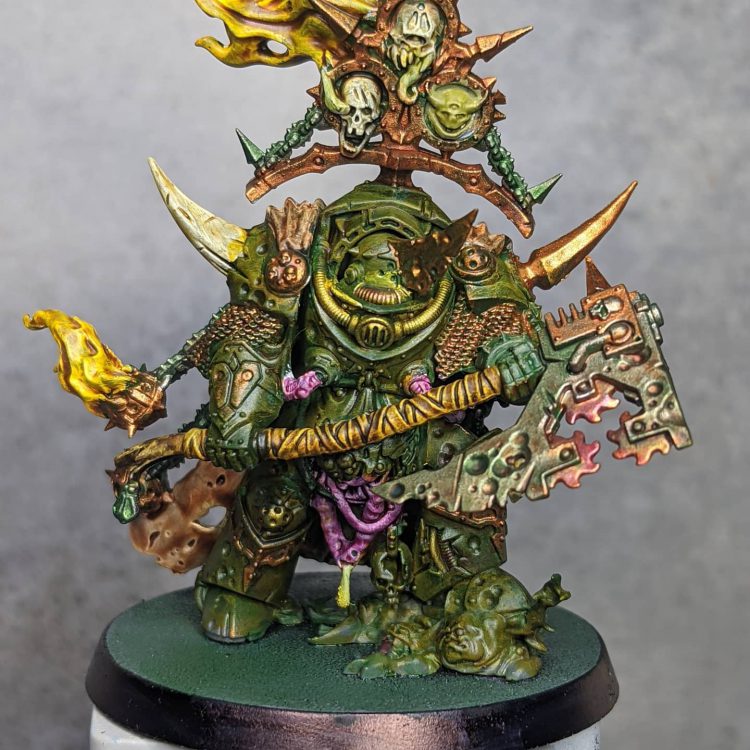
The Lord of Contagion comes with Terminator Armor, the Lord of the Death Guard Aura, and Vector of Disease, which ups his Contagion range by 3″ (to a max of 12″), ensuring he’ll be working with 6″ the turn he arrives if you have him Teleport in. The Lord of Contagion can opt for either a Plaguereaper, which gives you a 3-damage melee weapon, or the Manreaper and an Orb of Desiccation, which gives you a lot more versatility and is the correct choice in most cases. The Orb itself is a fun 3D3 shot, 2 damage grenade that will average 6 shots but if you get stuck in combat with it before you get a chance to lob it remember that it can be thrown while in Engagement Range via the use of The Blightening Stratagem, which will give you a solid 6 hits with it. The Lord of Contagion is probably the best of the non-psyker HQ options for Death Guard and his extended contagion range makes him a good model to have plague company contagions on, where he can easily hit max range for them early with the Flash Outbreak Stratagem, but giving him Hulking Physique to make him nigh unkillable is also a fine play. You’ll typically want to put him with other Death Guard Terminators.
Malignant Plaguecaster
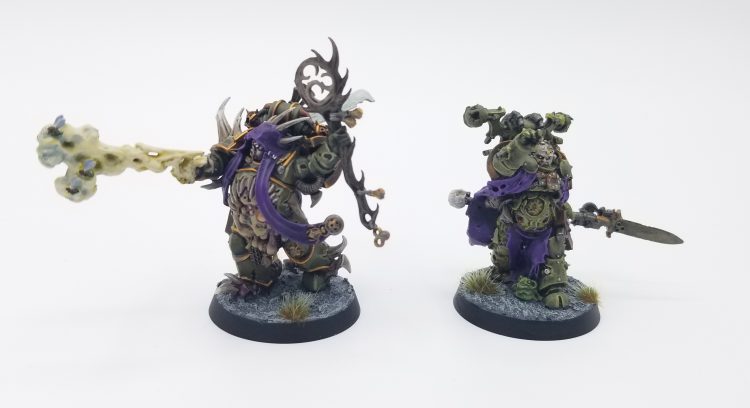
Your cheapest Psyker HQ, the Plaguecaster gives you a 4-wound, T5 power-armored body with the ability to cast two spells and each time you roll a 7+ to manifest, you throw out an extra mortal wound to the closest enemy within 12″. There’s not a ton to say about the Plaguecaster – they’re just very good units. They’re very helpful to have because the Contagion Discipline is good and so you’ll typically want one in your army. The big downside to these guys is that they’re pretty fragile thanks to not having an invulnerable save so be sure to keep them protected, and you will need to take one or a Daemon Prince to fill out a Battalion, keeping you off that sweet Abhor the Witch life.
Death Guard Sorcerer in Terminator Armour
A terminator-armored version of the Plaguecaster, only without the Pestilential Fallout ability to do a bonus mortal wound. This guy’s just not worth it.
Troops
Death Guard have three Troops choices, only two of which actually gain the Objective Secured rule – Plague Marines and Poxwalkers.
Plague Marines
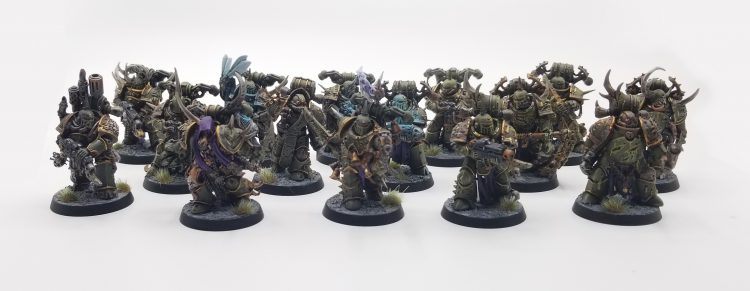
Plague marines are tough, versatile unit. They’re still reasonably tough and with the point drops that make their upgrades free, they’ve suddenly become a versatile backbone of the army, able to both put out some decent shooting when going heavy on plasma/meltaguns and blight launchers, or become melee nightmares when they sport flails, maces, and cleavers. Because they’re still slow, you’ll want to consider taking a rhino or two to cart them around.
Generally, while you get more value out of a 10-model squad when it comes to Stratagems, the tradeoff from the lost versatility on a 5-model squad isn’t worth it, and so you’ll want to go with a bunch of 5-man squads in your list. This is especially going to be the case as you find they don’t need many buffs to do what they want to do. These days lists seem to want more and more of these guys, and running six units of them isn’t uncommon.
Loadout: Load them up with the best of both worlds, giving units a flail and cleaver, plus a blight launcher and either a meltagun or plasma gun. Give the champion a plasma gun and a power fist, and swap his plague knife for a sword.
Something to Note: Giving your model a flail or cleaver does not take their knife away, meaning they still have two melee weapons, and as such, get +1 attack. So your model with a flail or cleaver has 3 attacks, not 2. Huge difference.
Poxwalkers
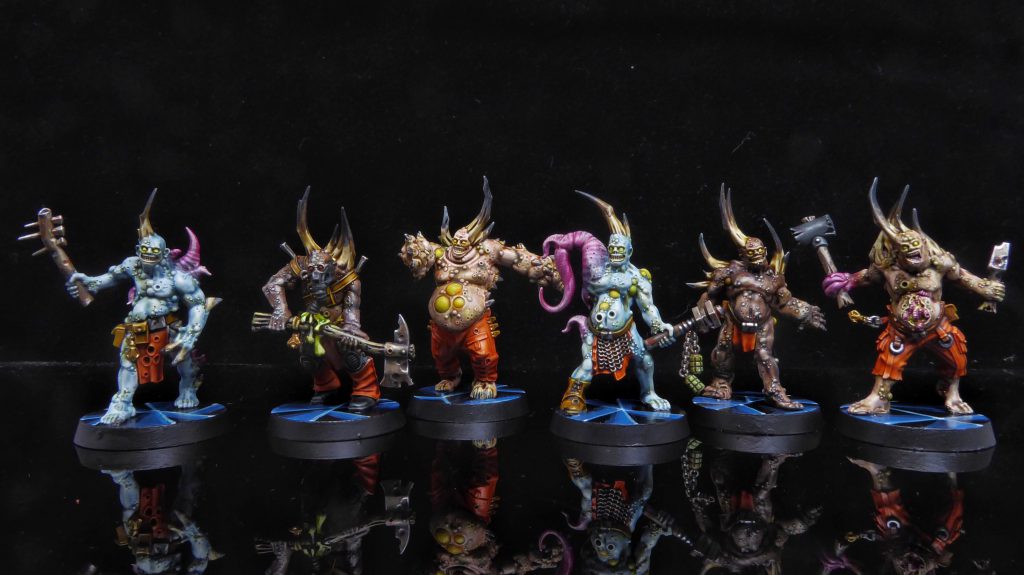
The workhorses of the Death Guard army, Poxwalkers are cheap, durable troops that can be an absolute chore to remove. They’re also slow as hell, with a 4″ movement. At 5 points per model for a T4 unit with a 6+ roll to ignore wounds and the ability to ignore morale however, they’re able to sit on objectives well and can regain models as they kill other models in melee, or through the The Dead Walk Again Stratagem. Poxwalkers are going to make it into most Death Guard lists, since at a minimum they’re very good cheap backfield objective holders. Of note is that they’re not BUBONIC ASTARTES and they can’t perform any actions except for Spread the Sickness, but they make excellent sickness spreaders thanks to being extremely expendable. There are a few ways to buff poxwalkers and Mutant Strain is a great way to punish armies that think they can just plow through the shambling hordes. Poxwalkers work great as either minimum size cheap objective holder units or as max size undying blobs, and filling out your remaining points with a unit of 17-18 is a fine play too.
Poxwalkers have lost some of their value now that Plague Marines are great, but a single unit at 50 points holding a backfield objective is still a decent play.
Death Guard Cultists
They don’t have Objective Secured, they aren’t CORE, and there’s not Death Guard equivalent of Tide of Traitors or Veterans of the Long War for them to use. Death Guard Cultists occasionally see use as a cheap unit to perform certain actions like Raise the Banners or Retrieve Octarius Data but that’s about it, and nowadays you’d rather just do that with Plague Marines anyways.
Elites
Death Guard Elites fall into four categories: Foetid Virion characters, Terminators, Possessed, and Helbrutes.
Noxious Blightbringer
The Blightbringer’s primary value is giving +1″ Movement to nearby CORE and Foetid Virion units, helping push your plague marines and their supporting characters (but not HQ choices, for some reason) across the table faster. That can make a real difference when you need to scoot a unit of terminators to the middle of the table without advancing, but it’s difficult to justify even his reduced cost (55 points) for that benefit – though the extra movement can catch opponents off-guard. It’s worth noting that the Blightbringer arguably gets you the most value on the Fugaris’ Helm relic, where you get to boost all three auras to 9″ and make them all a bit better. Otherwise, he’s more a nice-to-have than something you’ll build around, and that usually means he’s on the outside looking in when cuts happen.
Foul Blightspawn
The Foul Blightspawn has been toned down a bit since his 8th edition insanity – you’ll no longer ever want to stuff 3 into a list – but he’s still got a ton of value and is, along with the Tallyman, one of the two most useful Foetid Virion. The Blightspawn packs a Plague Sprayer – which even at Assault D6, S7, AP-3 2 damage is one of the army’s most effective anti-tank weapons – and an unholy death’s head grenade, a S5 one-use blight grenade. On top of this his real value comes from his Putrefying Stink ability, which lets you pick an enemy unit at the start of the Fight phase within 3″ to be ineligible to fight until every other eligible unit has done so. This is incredibly useful given how deadly Plague Marines and Death Guard terminators are in melee, forcing opponents to think twice before charging in where a Blightspawn can just completely wreck their day. Although still good, this guy is no longer a must-take in competitive lists, but he’ll still show up in most. His plague sprayer is still very good and giving it +6″ range with Overwhelming Generosity is hilarious.
The Loadout: The Blightspawn has his own custom relic, Revolting Stench Vats, which gives him a 6″ aura that turns off Fight first abilities and makes it so units in range never count as charging. This is one of the game’s best relics and the added range makes it harder to play around when your Blightspawn is embedded with a unit. If you’re taking a Blightspawn, you want the Stench Vats to maximize his utility. You can also greatly improve his shooting by giving him the Viscous Death Deadly Pathogen, upping his sprayer to S8 and giving him the ability to re-roll shots on it. This is more of a nice-to-have, but worth dumping your last 10 points into over some other upgrades. The Blightspawn also makes a very good fit for the Arch-Contaminator warlord trait, particularly if he’s being paired with Deathshrouds or Blightlords.
Biologus Putrifier
The Biologus Putrifier is notable for being the only Virion to come with a Plague Knife (though the Plague Surgeon gets a balesword), and he specializes in having better grenades and the ability to super-charge the grenades of nearby Death Guard. His most useful ability however is Foul Infusion, which allows him to super-charge a CORE unit within 6″ in the Charge or Fight phase, giving that unit the ability to do extra mortal wounds for each unmodified wound roll of 6 made with a plague weapon until your next Command phase (note this means a unit can be Double-infused during your opponent’s turn). This does fine work on all types of Terminators and Plague Marine squads using Trench Fighters for extra attacks, helping them take down tougher units and vehicles. This also combos exceptionally well with the Arch-Contaminator Warlord Trait, where you can use the full re-rolls to fish for mortals even when you’re already wounding on a 2+.
The utility of the Putrifier is mostly tied to the utility of larger squads of Plague deathshrouds or blightlords where you’ll get larger attack volumes to make use of Foul Infusion. So if you’re bringing a bigger unit of Terminators, there’s potentially a place for the Putrifier to tag along. Remember that he can infuse in the Charge phase, boosting a unit before it runs away from him, but this also makes it very easy to leave him unprotected. He’s a better fit for Arch-Contaminator than the Blightspawn and sees play in more lists competitively these days, where the need to punch out mortal wounds is larger than the need to hit first.
Tallyman
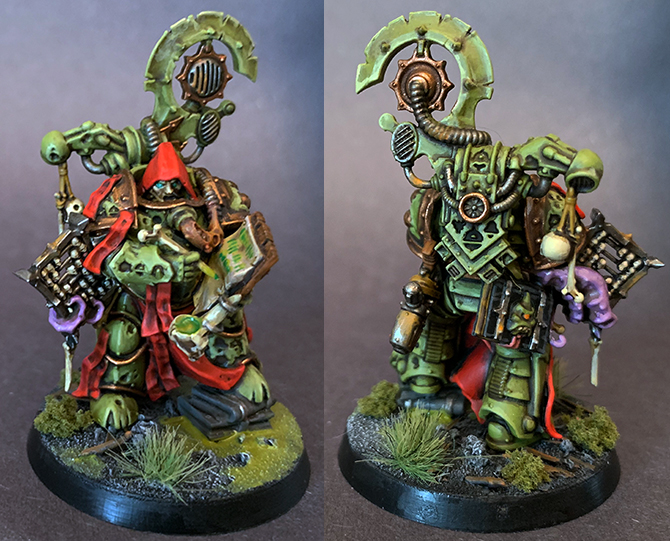
Potentially the most valuable of the Foetid Virion, the Tallyman has a place in nearly every competitive build for the Death Guard. This is almost entirely due to his Seven-fold Chant ability, which has you roll 2D6 each Command Phase and if you score a 7+, you gain a Command Point. Because you get to do this every Command phase, your chances of getting back 1 CP per turn are about 83%, meaning in an average game he’s worth 4 extra Command Points. On top of that his Malicious Calcuation ability lets you pick a friendly CORE unit within 6″ during your Command Phase to get +1 to hit until your next turn, giving him some extra value buffing units to a 2+ to hit.
In Nephilim this guy is basically a must-take and I can’t remember the last time I saw a Death Guard list without one.
Plague Surgeon
The Death Guard’s answer to the loyalist Space Marine apothecary, the Plague Surgeon is not quite as good – he can’t bring models back from the dead – but he can heal nearby BUBONIC ASTARTES INFANTRY for D3 wounds and his Tainted Narthecium aura gives friendly BUBONIC ASTARTES INFANTRY within 3″ a 6+ roll to ignore wounds. The former ability is great for keeping your Foetid Virion on the field and recouping wounds lost to Spread the Sickness. The latter is a neat way to get some extra durability on your Plague Marines and Terminators but it’s really difficult to get it on multiple units without investing a relic slot/CP into the Fugaris’ Helm and the effect itself is not quite strong enough to make the Plague Surgeon a must-include. He’s another nice to have who’ll often end up on the outside looking in and only really useful for protecting 10-model blobs of Blightlords. That said, he’s likely going to disappoint you most of the time, and just isn’t worth taking.
Blightlord Terminators
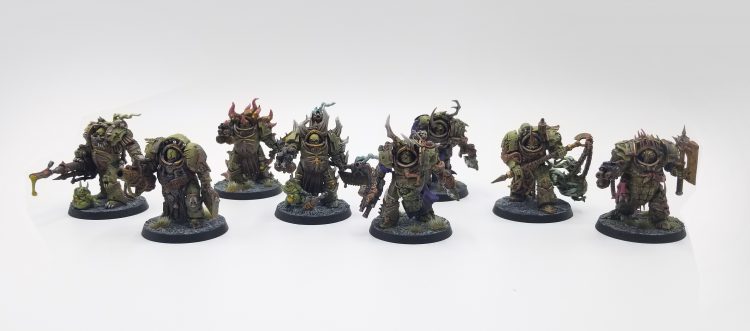
Blightlord Terminators are among the toughest infantry in the game, packing 3 wounds each, a 2+ save, and a 4+ invulnerable save. They also hit like a truck in melee and what they lack in shooting potency they make up for in volume, pouring out 4 bolter shots apiece with the ability to buff those with Virulent Rounds. In addition there are several ways to buff their output – Vermid Whispers is great for improving their accuracy by giving the unit +1 to hit in the Shoot or Fight phase, and Break Their Spirits is a fantastic way to turn 1-2 casualties in melee into something back-breaking for more elite infantry.
Thanks to the April 2022 Dataslate, Blightlord Terminators now have Objective Secured, and they got a helpful points drop in the Nephilim points update. That’s huge, and makes them a great objective-holding unit, since they can sit in the open and tank loads of firepower. There are two major problems with Blightlords:
- They are painfully, soul-crushingly slow, and have no ways to get faster. This means that your opponent can usually just run around them while scoring on you.
- They have a bunch of 1-damage weapons with relatively low AP, which means they need support from a Biologus Putrifier to really do damage.
Which is all to say that while the objective-holding core of your army is probably still Terminators, they can’t be the same workhorses that Scarab Occult Terminators are in Thousand Sons, with their D2 Khopeshes, AP-2 guns, and the ability to spit out mortal wounds. The upside is that because of the damage reduction and 4+ invulnerable save, you can probably get away with squads of 5 blightlords more readily than you can with Scarabs.
Loadout: You’ll typically want axes over baleswords, since the +2 Strength means that against T4 marines you’ll be wounding on a 2+ and re-rolling wounds after the Contagion kicks in to drop their toughness, and you can also threaten T7 targets. That’s still better than AP-3 in most cases, especially with Armour of Contempt gone. For the heavy weapon, both blight launchers or reaper autocannons are worth looking at, with the latter providing a lot of extra value at AP-2 and Heavy 4. You’ll also typically want to take a Flail of Corruption for every five models – while you giving up shooting with one model, you’ll more than make up for that with 6 attacks from the flail. A squad with one or two flails can get extra value by taking Plaguebringer on the champion to replace a balesword, giving you more damage that can, in a pinch, be carried over with the Haze of Corruption Stratagem.
Deathshroud Terminators
The elite bodyguard units of the Death Guard, Deathshroud are just as tough as Blightlords but sacrifice some ranged firepower for melee prowess. They have an extra attack compared to Blightlords and WS 2+, making them significantly more deadly in melee, plus their Manreapers give them the ability to push out multi-damage attacks that make them good targets for Haze of Corruption when you’re up against 1-wound models with a better save. Note that thanks to the April Dataslate, these have gained Objective Secured but lost the all-protective version of the Bodyguard rule, making them more of a sidegrade play to Blightlords rather than a must-take in the army.
The Nephilim Points update dropped the cost on these guys back down to their pre-December totals, once again making them a more playable alternative to Blightlords. This, coupled with now having the Objective Secured rule, makes them a solid alternative and a better inclusion in most lists.
Deathshrouds share a lot of the same weaknesses as Blightlords, trading off ranged firepower for the ability to do 2-damage swings in melee, which is a big upside but they still need the support of a Putrifier and a Tallyman to drive real value. The 5-model units will run you considerably more points than a unit of Blightlords at the same size, but on a per-model basis they’re better than Blightlords, and right now they hold the edge in terms of what you’ll want to take in most armies – one unit of 5 Deathshrouds is a solid play.
Helbrute
The Chaos version of a Dreadnought, the Death Guard Helbrute is more interesting for what he portends for the Chaos Space Marine faction than what he does for Death Guard. In 9th edition the Helbrute has traded 2″ of Movement for an extra base attack and an updated Frenzy rule, which now gives it the ability to re-roll wound rolls of 1 if it has taken any damage. Otherwise, it’s the same unit it always was, and that’s… not great. Dreadnoughts still suffer from having too little firepower for their cost, being too fragile even with -1 damage, and in the Death Guard Helbrute’s case, having little to no synergy with the rest of the army. While the Helbrute does have the CORE and BUBONIC ASTARTES keywords, it doesn’t have any plague weapons and can’t be healed or helped by a Plague Surgeon. If you do have to take one, the best loadout is probably one that uses the multi-melta and missile launcher, giving you a cheaper but slower, less armed, more fragile version of a Myphitic Blight-Hauler. As an alternative, you can give him a helbrute fist and a power scourge and use Haze of Corruption to turn the Helbrute into a very nasty melee combatant, able to pile on damage that spills over until everything is dead.
Death Guard Possessed
Possessed are the fastest infantry in the book, which is good because they take two spots each in a transport and top out now at squad sizes of 10 (instead of 20), significantly limiting their utility. They’re also limited by the fact that their weapons are 1 damage, making it hard for them to take down more elite multi-wound targets. Still, having a 7″ movement means they can close distances quickly and players will be quick to underestimate them, right up until they’ve crashed into the enemy’s lines. with a 5+ invulnerable save Possessed are a little more resilient as well but there isn’t much room for them in standard Death Guard armies. They’re at their best when buffed by a Tallyman and Biologus Putrifier.
Fast Attack
The Death Guard aren’t very fast, but they do have a few options with decent speed.
Chaos Spawn
Fast, moderately tough, cheap, and surprisingly capable in melee, Chaos Spawn feel like an odd unit out but are a great way to spend your army’s last 23-46 points, buying quick objective holders and harassers that can disrupt enemy strategies. They come with T5, 4 Wounds, and 2D3 attacks each, plus a randomly selected bonus of AP-4, an extra D3 attacks, or the ability to re-roll wounds and you’ll pretty much always want to upgrade a unit of them – particularly a unit of 2 or 3 – with Grandfather’s Influence, which boosts them to T6 and gives them Disgustingly Resilient. These are important because well, all they have is a 5+ armor save. Chaos Spawn aren’t particularly impressive on their own but they’ll seldom draw the appropriate amount of fire and if used properly they can generate more value than they cost.
Myphitic Blight-Haulers
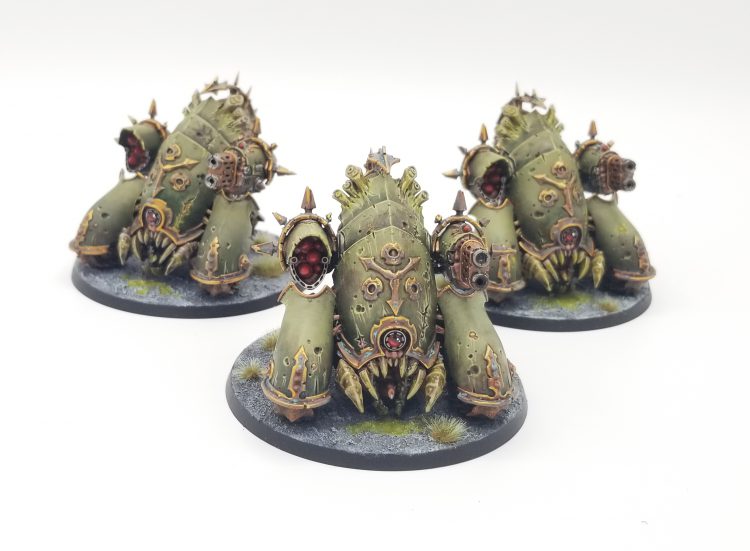
These adorable little bugs got a big boost in 9th edition, moving up to WS and BS 3+ and 9 wound apiece while gaining an extra shot on their multi-meltas and losing their reliance on being in a unit of 3. That’s good, because they’re more expensive as a result but now you’re free to take one or two in your army as fast, rangy anti-vehicle support. Blight Haulers do pretty well in that regard and get some additional resilience out of the the Belching Fumes Stratagem, which reduces the number of incoming shots from ranged weapons and incentivzes you for bringing a unit of two blight-haulers, dropping the CP cost to 1. Blight-Haulers are very good, and form the backbone of vehicle-heavy Death Guard Strategies, where they can use their speed and firepower to threaten heavier enemy units. Running three units of 2 is a viable option for competitive armies.
Blight-Haulers are among the more useful and reliable units in the book. Their speed and ability to throw out AP-4 melta shots makes them among the army’s best options for dealing with heavier threats, and they can provide great ranged support for slower terminator blobs. They also got a points drop in Nephilim, making them even more attractive as a unit of two.
Foetid Bloat-Drone

Bloat-drones are fast, durable daemon engines that can help make up for the army’s relative lack of speed and zip around the table to offer support. They’re Daemon Engines that come stock with Fleshmowers but can trade those out for either a pair of plaguespitters or a heavy blight launcher. Having 10″ movement and FLY basically makes them the army’s ideal targets for using Flash Outbreak to push contagions to distant enemy units for the rest of your army to take advantage of – both Ferric Blight and the standard Nurgle’s Gift are good effects in this regard. Bloat-Drones also have access to the Dark Cravings Stratagem, which gives them the ability to heroically intervene 6″ to reach targets and makes them incredibly deadly to be around when they’re kitted out for melee. Fleshmowers strike fear into the hearts of players who have gone up against them and they’ll frequenly be the first target your opponents go for.
Loadout: Fleshmowers are the way to go here, giving you some pretty nasty melee combatants who can throw out 12 S7 AP-2 2 damage attacks and be wherever you want them to be. It’s the best combo for Dark Cravings and also gives them the best chance of making use of the Daemonic Gluttony Stratagem to regain wounds. The Heavy Blight Launcher is also vastly underrated here, and while it isn’t as terrifying on the whole as the Fleshmower, it has good range and a very nasty gun that allow it to be active every turn of the game instead of just turns 2+.
Greater Blight Drone
The only “pure” Death Guard unit in the Imperial Armour Index book, the Greater Blight Drone offers a heavier, faster chassis than its smaller bloat-drone cousins, sporting a 14″ movement and 9 wounds. Its big weapon is the Blightreaper cannon, a souped-up Reaper Autocannon (Heavy 4, S7, AP-2 D1 plague weapon), plus a Bile maw to act as a filth flamer (18″ Assault D6, S7, AP-1, D1, automatically hits). The Greater Blight Drone isn’t packing any fancy special rules; it’s just a fast, durable unit that can zip around the board and do some decent damage. Its best effects come as a forward vector for Nurgle’s Gift, boosted in range by Gift of Plagues, and its best attribute is the cost – at 125 points it’s a steal. They sometimes show up in vehicle-heavy Death Guard lists as a fast, durable gun platform that can be a target for Flash Outbreak.
Heavy Support
Death Guard have a few Heavy Support choices, having split their predator options for some reason, but the only ones really worth considering are the Daemon Engines.
Plagueburst Crawler

Once a dedicated mainstay in Death Guard forces, the Plagueburst Crawler took a massive hit in the April 2022 Balance Dataslate with the changes to Indirect Fire. Now having an AP-2 indirect fire weapon isn’t nearly as good, but there’s still enough power behind it to make it worth bringing. The biggest problem with the unit is that a single one just isn’t consistent enough, and you’ll often only be able to get value out of them bringing 3 to mitigate entropy cannons only being one shot. The Entropy Cannons are still the army’s best ranged weapon, as S8 Plague weapons with AP-4 and a D3+3 damage characteristic, and with T8, 12 wounds, and disgustingly resilient, the tank can weather some real shooting before it starts to degrade. You’ll want to save CP for Disgusting Force on most turns you shoot it, since the mortar needs the damage upgrade to be really good. But in this context, the PBC moves from being a backfield objective holder to more of a midtable support play. They soak up a surprising amount of firepower early on and will draw fire away from other key targets in your army and they’re great for chipping away at guard and GSC infantry units to score Fleeing Vectors.
Chaos Land Raider
Death Guard Land Raiders lack Disgustingly Resilient and are just generally massively overpriced for what they offer. They also aren’t fast enough to be good transports.
Chaos Predators
Similar to Land Raiders, Death Guard Predators don’t gain Disgustingly Resilient either and don’t bring anything to the table that you can’t get from a PBC save the BUBONIC ASTARTES keyword.
Defiler
The trusty Defiler gets overlooked but has a lot to offer despite not picking up Disgustingly Resilient and no longer having access to Contaminated Monstrosity. It still retains Infernal Regeneration to regain lost wounds and it’s got enough that it can potentially survive a turn or two of shooting to make use of the ability to regenerate. Death Guard Defilers sport a new and improved profile in the book, with starting WS/BS of 3+ and 5 attacks (which it no longer loses as its profile degrades), Loaded with non-plague weapons, the Defiler makes a decent match for abilities like Ferric Blight or Sickly Corrosion, able to offer up long-range firepower to take advantage of those buffs. It straddles the line between ranged firepower and melee, being a very potent and capable melee combatant and as such, a model that wants to push up the battlefield with the rest of the army, but also prefers to take on targets that don’t leave it tied up through its shooting phase. You’re going to find that Defilers tend to be disappointing when they actually do get into combat, thanks to just not having enough melee attacks.
Loadout: Scourge and Reaper Autocannon. The Reaper is surprisingly versatile now that it has AP-2 and the Scourge is a must-have for the extra melee attacks it can dish out.
Dedicated Transport
There are two DT options to talk about for Death Guard.
Chaos Rhino
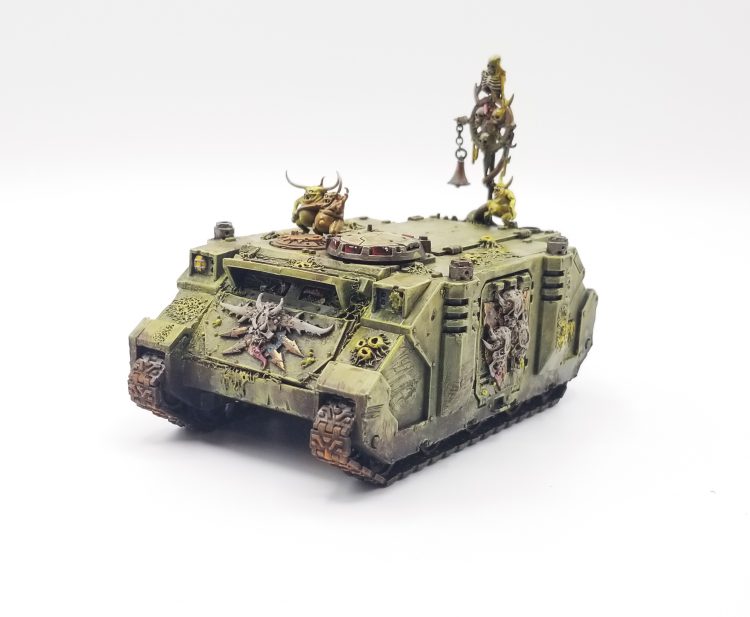
Rhinos have some real value to offer Death Guard – they don’t get Disgustingly Resilient, but they’re still fairly tough BUBONIC ASTARTES units with the Contagions of Nurgle ability and they can reliably ferry 10 infantry models (but can’t carry terminators or possessed). Rhinos are good transports for Plague Marines and a great way to mitigate their speed but the big challenge is that they only hold 10 models and so you’ll struggle to find ways to include the support characters that go with them. The “good” news is that some of those characters – such as the Tallyman – absolutely don’t want to be in a transport to begin with, since that locks him out of using his Sevenfold Chant ability to generate CP. Use Rhinos as a way to get slow squads around the table to cause problems where opponents aren’t expecting them. They’re more valuable now that Plague Marine are incredibly viable, and taking 1-2 in an army is pretty common. They also have tons of value after the plague marines get out, radiating contagion range and acting as movement blockers and decoys.
Chaos Terrax-Pattern Termite
As a transport that can hold 12 models – including 10 Death Guard Possessed thanks to a lack of errata – the Terrax would be an auto-include in lists if it had Contagions of Nurgle (though it does get BUBONIC ASTARTES), but as-is it’s merely a very solid unit to make use of, and its absence from lists says more about the Codex’s internal balance not requiring the drill than it does the drill itself. A T8, 14-wound vehicle, the Terrax does more than just ferry models to the battlefield – it sticks around and acts as a real threat in its own right once it arrives, able to use its melta cutter and Termite Drill to completely wreck enemy vehicles and heavy infantry. It essentially demands to be dealt with in a way that Rhinos don’t, forcing your opponent to choose between it and its occupants. Speaking of said occupants, the good fits here are the aforementioned possessed and squads of plague marines accompanied by a couple of Foetid Virion to support them. All that said, the Termite is an interesting include but not so much a necessary one, particularly given its cost.
Lord of War
There’s only one Death Guard Lord of War that matters and that’s the Primarch himself.
Mortarion
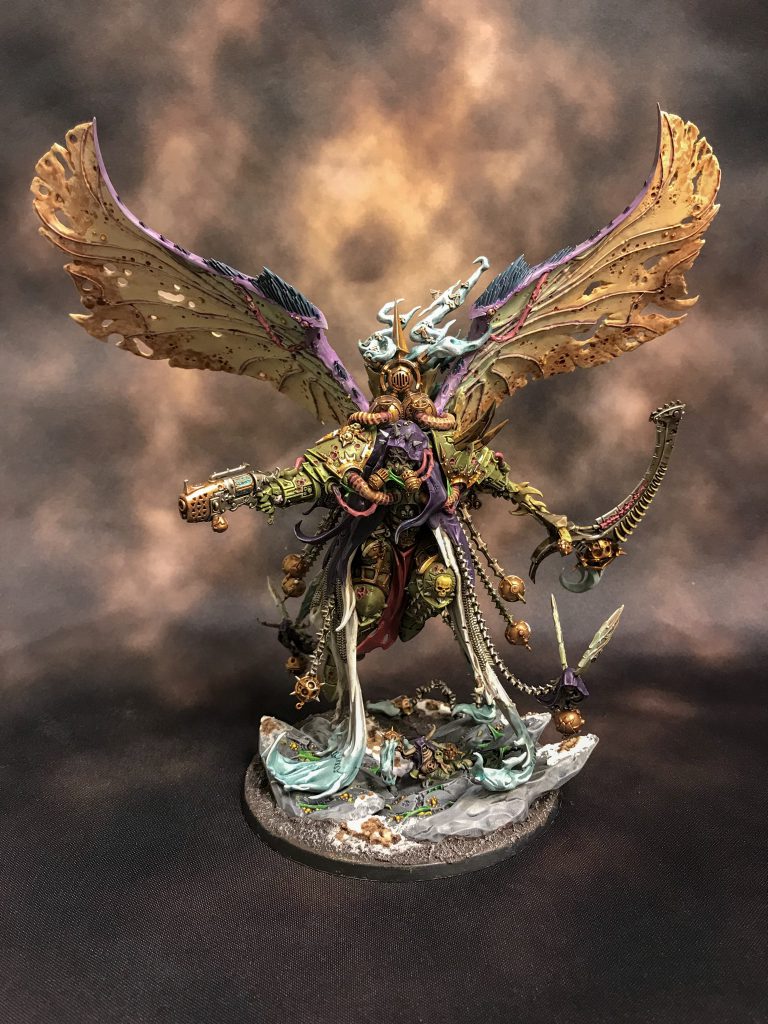
The Daemon Primarch of the Death Guard, Mortarion got a massive glow-up in the 9th edition codex and is now one of the game’s most fearsome units. Sporting T8, 18 Wounds, a 3+/4+ invulnerable save and, if he’s your Warlord, the ability to shrug off wounds on a 5+, Mortarion is an incredibly difficult model to bring down, and that’s before you consider that his degrading profile hardly degrades, losing only 4″ of movement and 2 attacks as he suffers damage. If you take Mortarion he has to be your Warlord and that’s perfectly fine because as your Warlord in a Supreme Command detachment he costs you 0 CP and comes loaded with three fixed Warlord Traits – Arch-Contaminator, Living Plague, and Revoltingly Resilient, plus your choice of one of the Plague Company Contagions, to be picked at the start of the game. This gives you a remarkable amount of tactical flexibility and combines well with Mortarion’s Toxic Presence ability, which always counts his Contagion abilities as being on turn 4, i.e. 9″ range. This makes him an ideal vector for Contagions like The Droning and Gloaming Bloat, where he can spend the first turn pushing into a position to affect large numbers of units with these abilities. He also comes with the standard Lord of the Death Guard Aura plus a separate Primarch of the Death Guard aura, which can give a CORE or CHARACTER unit (including himself) re-rolls on all hit rolls for a turn.
On the offensive side, Mortarion can pack quite a punch, able to completely mulch vehicles in a single turn thanks to having S8 and the Eviscerating Blow mode on his scythe, Silence. The effect is throwing out 5-7 S16, AP-4, D3+3 damage attacks that re-roll 1s to wound, meaning that most of the time he fights he’ll be hitting on 2s re-rolling and wounding on 2s re-rolling. If you’re up against single wound targets and don’t want to waste damage, or have a lot of invulnerable saves to worry about, then you can switch to the Reaping mode, which triples your attacks output at the cost of dropping to S8, AP-2, 1 damage, though you’ll likely still be wounding on 2s at that point. In addition to all of this, Mortarion is a Psyker who knows three powers, can cast two, and can attempt to deny three per turn (he really hates psykers). The powers you typically want on Mortarion are Miasma of Pestilence, so he can make himself even harder to kill, Curse of the Leper, which combines well with his increased Contagion range, and Gift of Plagues, to further boost his Contagion range to make use of his extra Contagion ability.
Generally speaking, when it comes to using his Scythe you want to use Eviscerating Blow most of the time against multi-wound models unless your targets will have a save of 3+ or better after you apply the AP from the attack, which will cause too many attacks for Eviscerating Blow to get lost on the save (usually an invulnerable save). This is something we explored in a recent Hammer of Math on reaping vs. Scything.
On the battlefield, Mortarion can be a force to be reckoned with. There are a few armies which just cannot deal with him in an effective manner, and some armies are better off avoiding him for as long as possible. But this is easier said than done: Mortarion has solid movement and an aura that gives him at a wide range of effect and you’ll find – especially at lower levels of play – that many players cannot resist the allure of attempting to remove Mortarion, leaving other units in your army alone while they take on the bigger single threat. This too is easier said than done, since it’s not uncommon for an entire army to shoot at Mortarion and only shave off 12 wounds. Once he makes his way into combat he can really start tearing things up, shredding through vehicles and light infantry alike and paving a way for the rest of your army. That said, it’s not all inevitability once he hits the table – Mortarion’s size and 18W profile make him very difficult to hide and there are several units that can just straight remove Mortarion from the table in one round, such as Sisters of Battle Retributors, who can use miracle dice to push through insane amounts of damage from their multi-meltas, or Drukhari piling on Dark Lances, and tough multi-wound units with a good invulnerable save like Bladeguard Veterans can easily tarpit Mortarion for several turns if he can’t remove them with psychic powers or if if he doesn’t have support. Avoiding these units is the key to getting your value out of Mortarion, who needs to put in some real work to justify his 450 point cost.
And unfortunately, it’s become harder and harder to actually put in that work, as more units can just avoid Mortarion while shooting has gotten much more deadly over the past year. T’au, Votann, and Eldar Shooting will absolutely take Mortarion off the table, making it necessary to put him in Strategic Reserves. When he’s not being shot off the table by Fire Prisms or Magna Rails he’ll struggle to make it into combat with viable targets, as many armies can screen Mortarion out and avoid him with faster units long enough to take care of him, and Reaper Hive Tyrants will gladly charge into him and ignore his damage prevention abilities. It’s now free to put him in Strategic Reserves, and you’ll want to do that pretty much any game where there are shooting threats on the table to ensure he gets a chance to act before being shot.
Fortifications
With the release of the 9th edition Codex, Death Guard got their own Fortification.
Miasmic Malignifier
The Malignifier is an odd unit. It pretty much falls into the same limbo realm as other army-specific fortifications, giving you a large model that can offer a decent benefit while not being able to move and potentially being unable to deploy on the battlefield, depending on the terrain and your TOs rulings. The Malignifier is a reasonably tough unit to destroy (T8, 12 wounds, Disgustingly Resilient) and offers an always-on turn 4 Contagion range for its Contagions, plus it can belong to a Plague Company and can use Flash Outbreak to take on custom contagions and push them out at a 12″ range for a turn. On the surface there’s a lot to like about the Malignifier, which can give nearby units the benefit of light cover and can be deployed outside your deployment zone, helping circumvent the challenge with fortifications being stuck in your zone all game. The challenge lies in the ambiguity around the rules for deploying it – as written, it’s not entirely clear whether it can circumvent the restriction around deploying within 3″ of another terrain feature – the rules for the Malignifier outline how it can be set up, but these conflict with the standard rules for fortification set-up and it’s unclear whether those still apply. Check with your TO first. That said, this is more than enough to torpedo competitive play for a unit that was at best borderline to begin with – the benefits are OK but not amazing and the unit doesn’t do enough for its cost to justify over something more mobile.
Other Forge World Units
Death Guard armies can add units from any of the Heretic Astartes options (well, those that can be NURGLE, anyways), in Imperial Armour Compendium, and when they do those units gain the BUBONIC ASTARTES keyword and can be assigned to a Plague Company.
Decimator
The daemon engine cousin of the Contemptor, Decimators see mixed competitive play (mostly in Chaos Space Marine armies) thanks to their ability to double up on Soulburner Petards and spit out 4D3 mortal wounds per turn. This plays very nicely with Sickly Corrosion, which can be used to give the Decimator re-rolls on 1s to wound with the Petards, helping maximize their output.

Chaos Contemptor Dreadnoughts
An outside pick but one with value, the Chaos Contemptor will cost you 1 CP to field but has the CORE keyword and is a bit more survivable than the Helbrute thanks to 9W and a 5+ invulnerable save, with greater speed (8″) and the ability to dish out more firepower. They still suffer from not having any plague weapons, but can make up for that in part with a few solid options that the rest of the Death Guard army just can’t match. The most notable of these is the twin volkite culverin, a 45″ Heavy 8 weapon that’s S6 AP0 2 damage but makes up for the lack of AP by doing mortal wounds on unmodified wound rolls of 6. The ability to double up on these and toss out 16 shots per turn while still getting re-rolls and buffs from characters like the Tallyman or Daemon Prince is a pretty nasty combo and it’s a particularly solid effect to combine with the Tollkeeper relic, where you’ll score an average of 2-3 extra hits without re-rolls. These also work especially well with the Ferric Blight from the Inexorable, as AP-1 makes a world of difference for them. If you’re feeling frisky and less concerned with competitive play, you can swap one out for a chainfist and use Haze of Corruption to make its 2D3 damage spill over.
Playing Death Guard
Death Guard armies tend to live up to their portrayal in the fluff – they’re slow but relentless and tough as nails, holding positions and weathering firepower that would shred similar units in other armies. Even their chaff units take a significant investment to actually kill, thanks to shrugging off 1 in 6 wounds and being immune to morale. Your strategy with Death Guard will largely revolve around having one cheap backfield holder on your “home” objective while you split the bulk of your army into two ObSec blobs to hold two objectives at mid-table, hoping that your resilience and obsec terminators can carry you through on primary scoring. Your biggest challenge will be converting this into a win on 6-objective maps that require you to hold three and more to score full points on primary, and you’re going to struggle with those.
If you’re running lots of plague marines, your strategy will largely revolve around going “wide” and Advancing them all over the map, having lots of support across multiple waves. Plague Marines are pretty damn tough, especially in cover, and can hit like a freight train in melee when they have double cleavers and double flails. They’re also capable of weathering a hit and then fighting back. Generally speaking, Death Guard aren’t a gunline army, they’re a melee army, albeit a slow one. You want your guys pressing forward, shooting with meltas and plasmas when you can, and then doing loads of damage in melee combat with kitted-out squads.
When it comes to picking secondary objectives, Spread the Sickness is going to be on your list most of the time, as it’s relatively easy to get 10 VP on and hard to disrupt. You may look at Raise the Banners if the mission doesn’t work for you but that’s typically also going to be worth 10 at most and potentially less if you get caught out of position. After that Warp Ritual can be a good pick if you have a second caster and aren’t facing rough headwinds, though you shouldn’t take it if your opponent can Deny it. After that you will usually want a Kill Secondary.
If a kill secondary isn’t on the menu – No Prisoners, Assassination, or Bring it Down don’t seem feasible, then you’ll want to turn to either Grind Them Down or Fleeing Vectors as your next plays. Grind isn’t great, but it’s as good for Death Guard as it is anyone, and it’s achievable in a decent number of matchups, plus your Plague Marines will score you bonus CP for kills when you take it. In a pinch you can use teleporting Deathshrouds to score Behind Enemy Lines, though not being able to score it T1 hurts.
Generally speaking with Death Guard you’re going to struggle to score 100 VP because your secondaries just don’t support it, but your floor will also tend to be pretty high as well.
Soup Lists
Generally speaking, Death Guard have two soup options, Chaos Daemons and Chaos Knights, and when you’re adding either to your list it’s worth asking “What do these bring to the table that I can’t get with my existing army?”
In the case of Chaos Knights, the answer is really “long-ranged shooting.” Taking a big knight doesn’t give you much that Mortarion couldn’t do, so you’re really looking at the triple war dog option, and of those options, a trio of Executioners gives you the most unique offering. A Warp-sight unit of Dreadblades can sit back and hold objectives from your backfield while reliably putting out 3-damage autocannon shots that ignore cover from across the table, giving your plague marines and deathshrouds cover as they advance. Note however that this is an expensive proposition – it costs you 3 CP and you’re going to sacrifice some of your army’s heavier firepower to pull it off, as each war dog costs you about the same as a plagueburst crawler. Though on that note, there’s a legitimate question of whether you can just do most of the same job with PBCs, where the mortars + entropy cannons with line of sight give you similar offensive outcomes.
For Chaos Daemons, there’s a single answer to this question and it’s “Forge World Bullshit.” Mamon the Transfigured is a Daemon Prince of Nurgle in the Imperial Armour Compendium is unique in that he has an aura to re-roll 1s to hit for NURGLE DAEMON units, the lone unit in the game with such an ability. That means he can give huge boosts to PBCs and Soul Grinders (which are T9 in Death Guard), and there are some interesting artillery lists out there that have done this to great effect. You’ll still need to take a unit of Poxwalkers if you do this, but you can also add a unit or two of Nurglings to help offset your speed deficiency, which is another upside.
Note that, as of this writing, the Death Guard do not have an exemption for AGENT OF CHAOS units like Chaos Space Marines, and so cannot include Abaddon as a Warlord without losing Contagions. The Codex: Daemons and Codex: Chaos Knights books both have their own, separate exemptions which cover including them in a Death Guard army.
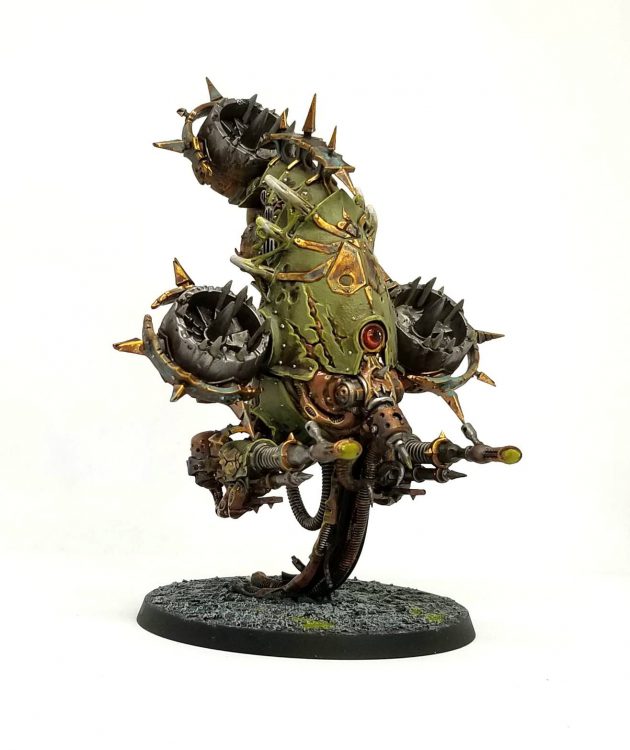
Tips and Tricks
- Tough doesn’t mean invincible. Just because your Death Guard units are very tough doesn’t mean they’re invincible. If you overextend or leave them exposed, they’re still going to die. Your units are strong enough to press forward and occupy the center of the board but you’ll still want to keep them protected, out of line of sight or in cover, to maximize these strengths and make them as difficult to remove as possible. Also, you’re going to find out that mortal wounds will absolutely tear through you when you go up against the psychic armies. Try and avoid those and screen them out where you can.
- Load up on Relics and Warlord Traits. You’ve got some great relics and warlord traits in the army and you should use them. Almost every Death Guard army will double or triple up on Warlord Traits and Relics. The effects are too good to pass up and are easily worth an extra CP or two.
- Figure out your planned buffs and stratagem combos before the game. Death Guard have a lot of ways to confer one-turn buffs or bonuses to a unit and sometimes you’ll want to stack several of these on a unit to power them up for a turn. Have an idea of which abilities you’re going to use for this before the game so you don’t forget to add key effects while you’re mid-battle.
- Don’t forget to roll for your Tallyman every turn. Maybe this should have been fixed via errata but it wasn’t, and so if you bring a Tallyman, be sure to roll in every Command Phase for those extra CP.
- Look for opportunities to use Break Their Spirits. Even if you’re only taking Typhus, a Lord of Contagion, or a Lord of Virulence, look out for opportunities to use this Stratagem. Dropping an easy -4 Ld on a unit taking a loss of 1+ models can be devastating against marines and other elite armies where suddenly you’re adding another 1-2 model deaths on top of your damage or, just as good, forcing your opponent to spend 2 CP for your 1.
- Look for free movement opportunities. When you have to walk across the table, especially with Terminators, you need to get creative about moving. Your best opportunities for shooting across the table will come from charges – look for opponents to get too close, then punish them for it and slingshot an extra 7-12″ across the table. Just be careful you don’t overextend and leave your characters in the open.
Playing the Mirror Match
It’s one thing to play Death Guard and be familiar with the army; it’s another thing entirely to play against them. Here are some pointers for going up against Death Guard with your own Death Guard:
- Several key tricks don’t work. The splash damage from Disgusting Force and explosions from characters and your smaller vehicles won’t damage Death Guard (or NURGLE) units, making them much less dependable. You’ll still occasionally want to use Disgusting Force to get 3-damage shooting, though. Additionally, Ferric Miasma won’t slow down BUBONIC ASTARTES chargers, making it only useful against poxwalkers and daemon engines.
- Shooting your PBCs at their PBCs is a waste of time. PBC shooting into other PBCs is miserable. The only weapon that actually gets value is the entropy cannons and you’ll be lucky to get 4 damage per volley out of it. Instead, use your mortars to pick off poxwalkers and the backfield objective holders that allow your opponent to extend and focus on bad-touching their PBCs.
- Avoid being too aggressive. Your Death Guard love it when someone walks into your 24″ range or gives you free charges. They do too. Pick your spots carefully and avoid walking into their trap before it’s time.
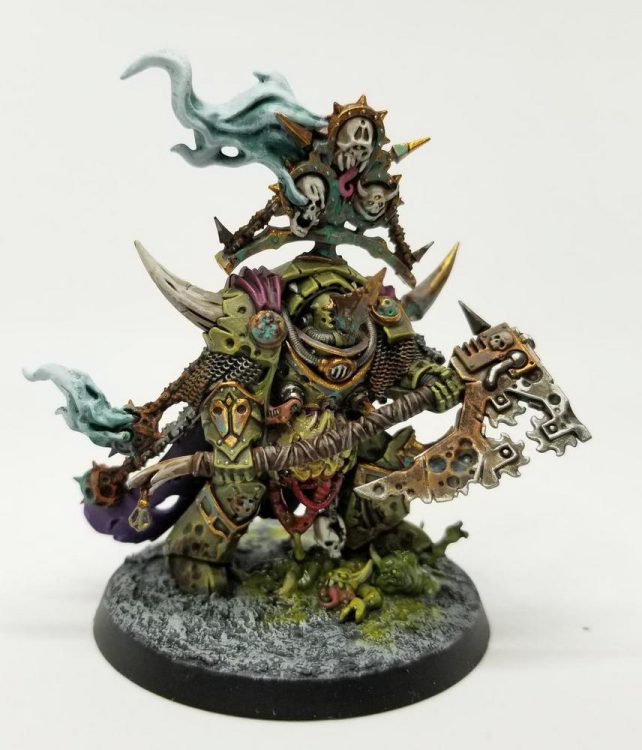
Some Example Lists
The competitive landscape isn’t great for Death Guard, but they have some play. For up to date top lists, check out 40kstats.com, which tracks all of the top lists for competitive play for every faction.
Robert Hawkins’ List
Robert took this list to a third-place finish at the Mayhem GT event in April 2023.
++ Arks of Omen Detachment (Chaos – Death Guard) [120 PL, 2,000pts, 3CP] ++
Plague Company: The Ferrymen
+ HQ +
Typhus [9 PL, 165pts]: 1. Miasma of Pestilence, 4. Putrescent Vitality
+ Troops +
Plague Marines [12 PL, 190pts]
. Plague Champion: Plague knife, Plasma gun
. 2x Plague Marine w/ blight launcher: 2x Blight grenades, 2x Blight launcher, 2x Krak grenades, 2x Plague knife
. 2x Plague Marine w/ cleaver: 2x Blight grenades, 2x Great plague cleaver, 2x Krak grenades, 2x Plague knife
. 2x Plague Marine w/ flail: 2x Blight grenades, 2x Flail of corruption, 2x Krak grenades, 2x Plague knife
. Plague Marine w/ icon and sigil
. Plague Marine w/ special weapon: Plasma gun
. Plague Marine w/ special weapon: Plasma gun
Plague Marines [12 PL, 190pts]
. Plague Champion: Plague knife, Plasma gun
. 2x Plague Marine w/ blight launcher: 2x Blight grenades, 2x Blight launcher, 2x Krak grenades, 2x Plague knife
. 2x Plague Marine w/ cleaver: 2x Blight grenades, 2x Great plague cleaver, 2x Krak grenades, 2x Plague knife
. 2x Plague Marine w/ flail: 2x Blight grenades, 2x Flail of corruption, 2x Krak grenades, 2x Plague knife
. Plague Marine w/ icon and sigil
. Plague Marine w/ special weapon: Plasma gun
. Plague Marine w/ special weapon: Plasma gun
Plague Marines [12 PL, 190pts]
. Plague Champion: Plague knife, Plasma gun
. 2x Plague Marine w/ blight launcher: 2x Blight grenades, 2x Blight launcher, 2x Krak grenades, 2x Plague knife
. 2x Plague Marine w/ cleaver: 2x Blight grenades, 2x Great plague cleaver, 2x Krak grenades, 2x Plague knife
. 2x Plague Marine w/ flail: 2x Blight grenades, 2x Flail of corruption, 2x Krak grenades, 2x Plague knife
. Plague Marine w/ icon and sigil
. Plague Marine w/ special weapon: Plasma gun
. Plague Marine w/ special weapon: Plasma gun
Poxwalkers [6 PL, 70pts]
. 14x Poxwalker: 14x Improvised weapon
Poxwalkers [3 PL, 50pts]
. 10x Poxwalker: 10x Improvised weapon
+ Elites +
Biologus Putrifier [4 PL, 60pts]
Foul Blightspawn [6 PL, 85pts, -1CP]: Revolting Stench-vats, Stratagem: Gifts of Decay, Viscous Death
Tallyman [4 PL, 65pts, -1CP]: Stratagem: Gifts of Decay, Tollkeeper
+ Fast Attack +
Foetid Bloat-drone [7 PL, 115pts]: Fleshmower
+ Heavy Support +
Plagueburst Crawler [8 PL, 145pts]: 2x Entropy cannon, Rothail volley gun
Plagueburst Crawler [8 PL, 145pts]: 2x Entropy cannon, Rothail volley gun
+ Dedicated Transport +
Chaos Rhino [4 PL, 80pts]
+ Lord of War +
Mortarion [25 PL, 450pts, -1CP]: 1. Revoltingly Resilient, 2. Living Plague, 4. Arch-Contaminator, 5. Curse of the Leper, 6. Gift of Plagues, Gloaming Bloat, Stratagem: Warlord Trait, Warlord
++ Total: [120 PL, 2,000pts, 3CP] ++
Standout Features
- Mortarion
- The Ferrymen as Plague Company
- Typhus
- Three big units of Plague Marines
This list has some meaty targets, starting with reduced-cost Mortarion. Between him and Typhus it has a ton of denies to handle pesky Eldar lists, and if the opponent is focusing on Mortarion it’ll be getting shelled by the PBCs. The list doesn’t get a ton out of the Ferrymen plague company choice, but it does get the ability to up the range on the Blightspawn’s stench vats to 12″ and it’s running 3 full-size plague marine units to hold objectives and bully units off the table, with one rhino to scoot one further upfield.
Noah Nuendorfer’s List
Noah’s list runs a big unit of Blightlords and took him to a 4th-place finish at Battle Ready Wargaming’s Major 40k event in March, 2023.
++ Arks of Omen Detachment (Chaos – Death Guard) [116 PL, 1,996pts, 2CP] ++
Arks of Omen Compulsory Type: Elites
Plague Company: The Ferrymen
+ No Force Org Slot +
Tallyman [4 PL, 65pts]
+ HQ +
Malignant Plaguecaster [5 PL, 90pts, -1CP]: 1. Miasma of Pestilence, 4. Putrescent Vitality, Bolt pistol, Stratagem: Warlord Trait, The Droning, Warlord
Typhus [9 PL, 165pts]: 5. Curse of the Leper, 6. Gift of Plagues
+ Troops +
Plague Marines [12 PL, 190pts]
. Plague Champion: Daemonic plague blade, Plasma gun, Power fist
. 2x Plague Marine w/ blight launcher: 2x Blight grenades, 2x Blight launcher, 2x Krak grenades, 2x Plague knife
. 2x Plague Marine w/ cleaver: 2x Blight grenades, 2x Great plague cleaver, 2x Krak grenades, 2x Plague knife
. 2x Plague Marine w/ flail: 2x Blight grenades, 2x Flail of corruption, 2x Krak grenades, 2x Plague knife
. Plague Marine w/ icon and sigil
. Plague Marine w/ special weapon: Meltagun
. Plague Marine w/ special weapon: Meltagun
Plague Marines [12 PL, 190pts]
. Plague Champion: Daemonic plague blade, Plasma gun, Power fist
. 2x Plague Marine w/ blight launcher: 2x Blight grenades, 2x Blight launcher, 2x Krak grenades, 2x Plague knife
. 2x Plague Marine w/ cleaver: 2x Blight grenades, 2x Great plague cleaver, 2x Krak grenades, 2x Plague knife
. 2x Plague Marine w/ flail: 2x Blight grenades, 2x Flail of corruption, 2x Krak grenades, 2x Plague knife
. Plague Marine w/ icon and sigil
. Plague Marine w/ special weapon: Plasma gun
. Plague Marine w/ special weapon: Plasma gun
Plague Marines [12 PL, 190pts]
. Plague Champion: Daemonic plague blade, Plasma gun, Power fist
. Plague Marine w/ blight launcher
. 2x Plague Marine w/ cleaver: 2x Blight grenades, 2x Great plague cleaver, 2x Krak grenades, 2x Plague knife
. 2x Plague Marine w/ flail: 2x Blight grenades, 2x Flail of corruption, 2x Krak grenades, 2x Plague knife
. 2x Plague Marine w/ mace and axe: 2x Blight grenades, 2x Bubotic Axe, 2x Krak grenades, 2x Mace of Contagion, 2x Plague knife
. 2x Plague Marine w/ plague spewer: 2x Blight grenades, 2x Krak grenades, 2x Plague knife, 2x Plague spewer
Poxwalkers [3 PL, 50pts]
. 10x Poxwalker: 10x Improvised weapon
+ Elites +
Biologus Putrifier [5 PL, 65pts, -1CP]: 4. Arch-Contaminator, Befouling Runoff, Stratagem: Plaguechosen
Blightlord Terminators [20 PL, 400pts, -1CP]
. Blightlord Champion: Balesword, Combi-melta, Plague Skull of Glothila, Stratagem: Champion of Disease
. Blightlord Terminator: Balesword, Combi-melta
. Blightlord Terminator: Blight launcher, Bubotic Axe
. Blightlord Terminator: Blight launcher, Bubotic Axe
. Blightlord Terminator: Flail of corruption
. Blightlord Terminator: Flail of corruption
. Blightlord Terminator: Balesword, Plague spewer
. Blightlord Terminator: Balesword, Plague spewer
. Blightlord Terminator: Balesword, Combi-flamer
. Blightlord Terminator: Balesword, Combi-flamer
Foul Blightspawn [6 PL, 85pts, -1CP]: Revolting Stench-vats, Stratagem: Gifts of Decay, Viscous Death
+ Fast Attack +
Chaos Spawn [1 PL, 21pts]: Chaos Spawn
Foetid Bloat-drone [7 PL, 115pts]: Fleshmower
+ Heavy Support +
Plagueburst Crawler [8 PL, 145pts]: 2x Entropy cannon, Heavy slugger
Plagueburst Crawler [8 PL, 145pts]: 2x Entropy cannon, Heavy slugger
+ Dedicated Transport +
Chaos Rhino [4 PL, 80pts]: Combi-melta, Havoc launcher
++ Total: [116 PL, 2CP, 1,996pts] ++
Standout Features
- A pair of casters in the HQ spots
- A 10-model unit of Blightlords
- Three 10-model units of Plague Marines
Eschewing Mortarion for a brick of Blightlords, this list is more dedicated to trudging to the middle of the table – something that you’re largely rewarded for in more than half of the Arks missions. It preserves some speed with a Fleshmower and a Rhino, and keeps the trio of max-size plague marines to play with.
Final Thoughts
Well that about wraps things up. Hopefully by now you’ve got a good idea of what’s going to work and what won’t in your Death Guard army, and you’ve got the foundation you need to start experimenting. As always, if you’ve got a question or comment about the article or your army, feel free to drop us a question in the comments below, or email us at contact@goonhammer.com.

